Today’s investigation is just a brief wandering into some recent ruminations. I’ve been thinking a lot about the long-razed TraveLodge motel on the northwest corner of 39th and Dodge and was pleasantly surprised when I came across a postcard of it on Ebay. This led to buying every postcard of it on Ebay—a sickness I adopted from Mr. Alexander Payne. My childhood fascination with the TraveLodge’s drowsy, night-shirted, sleeping-capped, little cub logo, perfectly coined, “Sleepy Bear” is filed securely in my 1970s memory bank but as I matured, and the motel too, there built a tarnish on this site. Eventually, in the late 1980s TraveLodge transformed into The Travel Inn, widely recognized as The Crack Motel among my music and underground scene friends. Apologies for my bluntness. Living in the neighborhood, a good portion of my early 1990s life was dedicated to strategically avoiding 39th and Dodge on foot. I have since heard a few accounts of acquaintances meandering through those occupied motel chambers. In those days any passersby could make out the occasionally soiled mattress perched on the balconies or frequently attract unexpected attention from the tenants reclining in odd hospitality chairs, engaged in smoking and drinking outside their rooms. The renowned Saigon Vietnamese restaurant would later move into the small, time capsule diner, the former coffee shop of the TraveLodge, resulting in a peculiar amalgamation of clientele in the parking lot, just shy of perilous. Did I know about the murders? I only remember going to the restaurant, after avoiding the corner for so long, felt like high adventure at the time. Among other head scratchers, the very existence of the TraveLodge on this particular corner, in this gorgeous historic neighborhood, remained a mystery to me.

Sleepy’s very own TraveLodge stationary from the 1960s.
In 1960 the president of the Travelodge Corporation of California, Scott King, expressed enthusiasm in introducing Omaha’s inaugural “near-downtown motel” to 39th and Dodge at a price tag of $750,000.
At the time of King’s Omaha acquisition, TraveLodge operated 158 motels. TraveLodge had been established in 1940 in San Diego. Marketed to families with children, (their mascot certainly lured me in!), TraveLodge was an early budget motel chain. They distinguished themselves by offering lower rates in “near downtown areas” where hotel prices were often higher. There were no frills, no amenities and no concierge service offered at TraveLodge.

Image from OWH. July of 1960. Draftsman’s sketch of the future motel, TraveLodge, at 39th and Dodge.
The initial Omaha TraveLodge design envisioned a three-story structure positioned to face Dodge Street, set back approximately ten feet and including a ramp entry from that major thoroughfare. (Smartly, they observed our driving habits in this fare city and made changes.) Curiously, the construction site was described as a plateau that loomed over Dodge, and designs were created to gradually lower the property until it reached a height of only around two feet above the grade level. This was a point I was very interested in and will be explained later. The TraveLodge plan boasted of a future heated outdoor swimming pool and would have a brick and concrete exterior. “It will contain no restaurant, bar or ballroom. We’re strictly in the lodging business.”
Did anyone question this cinder block MCM aesthetic for midtown, let alone that it was a grand neighborhood? This TraveLodge plan resembled the type of structure often located at 74th and Dodge or 112th and West Dodge of that era.
At first dig, I thought Joel O’D. Cornish, Omaha famous attorney, had sold the large parcel to Travelodge Corporation in July of 1960. Later it was revealed Cornish’s land was leased on a 50 year contract to TraveLodge. It turned out this was just a portion of Joel Cornish’s property, whose stately home at 120 North 39th Street was just north of the proposed motel. Of this leased land it was said “One house on the building site undoubtedly will be torn down.” It turns out this “one house” was 112 North 39th Street, the palatial home of Charles Henry Pickens. Why was Cornish selling out parcels Omaha’s once exclusive Nob Hill? And why would a family want to lower the value of their home and that of their neighbors by squeezing a budget motel on their block?

The Daily Record. July 20, 1960.
The North 39th Street Gold Coast
I’ve written quite a bit about Omaha’s Gold Coast, both north and south of Dodge, and I do hope you go digging into my archives to investigate further. This area has known many names over the years–the once exclusive West Farnam District in the early days, the Blackstone District, but on this north side of Dodge, specifically on 39th Street and the surround, the Joslyn Castle Neighborhood of late. By way of a concise overview, it may be stated that the residences constructed on North 39th Street, spanning from Davenport on the north, to Dodge Street on the south, were formerly referred to as Nob Hill. Surely a nod to “Hob Nobbing”–the epitome of societal excellence within the larger Gold Coast, the inner ring within the already posh district,
Please refer to these two articles for a more thorough examination of North 39th Street:
Bertha Yost Offutt and the Mysterious Gold Coast Mansion
Bertha Yost Offutt and the Mysterious Gold Coast Mansion Part Two

Early postcard from 1904 (at least that is when this was mailed). Camera is on 39th Street, looking north at the Joslyn residence bookending the block. I would surmise this was taken south of Dodge as there were never that many homes constructed on the much shorter Nob Hill from Davenport to Dodge on the north. For the record, Omaha’s affluent families also lined South 39th Street; however, today we are concentrating on the area restricted to north of Dodge.
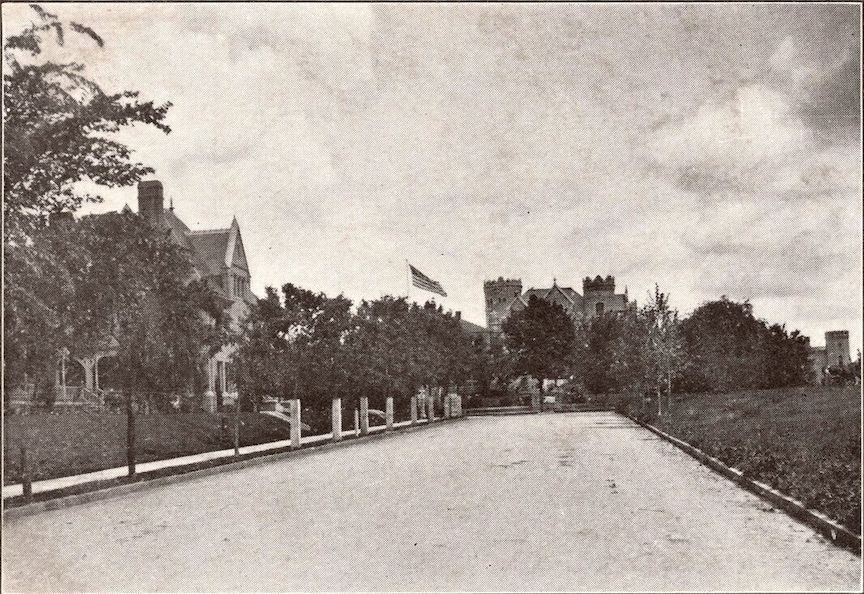
1907 postcard. Camera faces northwest. Joslyn residence (3902 Davenport Street) on the north end; the Bertha Yost Offutt and Charles Offutt home (140 North 39th Street) viewed on the left side of the photo. The original ornate Victorian porch of 132 North 39th Street is spied just south of the Offutt residence.
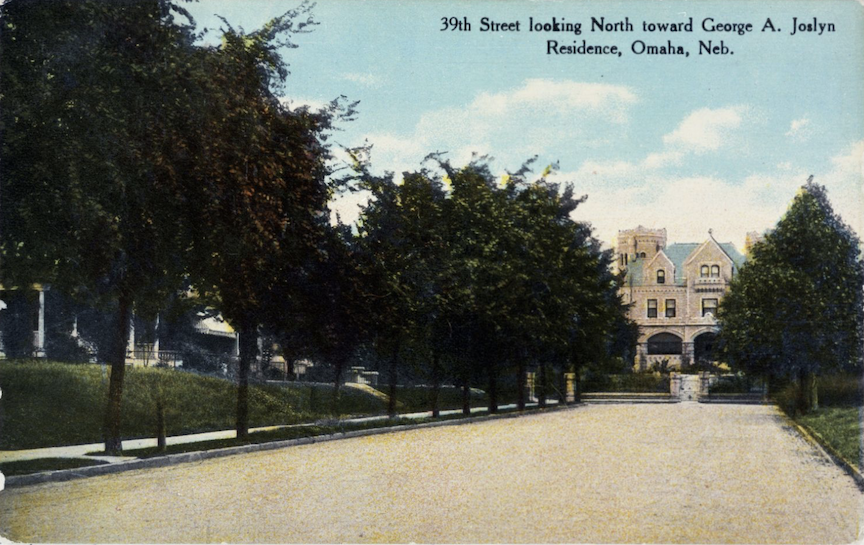
Vintage postcard, hand painted. Camera faces north on 39th Street, slightly western angle. Watch the trees grow.
In her captivating book Born Rich, Margaret Patricia Killian provided a detailed account of the area, including a graph that plotted the houses and their respective families. The society district also received mention in B. F. Sylvester’s phenomenal book West Farnam Story, which I will refer to in a bit. An Inventory of Historic Omaha Buildings by the Landmarks Heritage Preservation Commission ( 1980) documented the North 39th Street homes that survived both the 1913 tornado and lived to see the Commission’s 1980 publication.
The Cast of Characters
In the 1880s “the Cream of Residence lots” were situated on the high grounds between Dodge and Davenport, and “fine groves of forest trees affording ample shade” were said to be all around. These parcels were divided into Kilby Place and Crescent Park developments.
Following are some photographs that serve to visually represent the architectural significance of the structures located on North 39th Street, to comprehend the impact of the TraveLodge announcement of 1960. I have included very brief introductions of the current extant buildings and then we will review the two mansions that were torn down.
But first, a map to get the lay of the land–because I love maps.
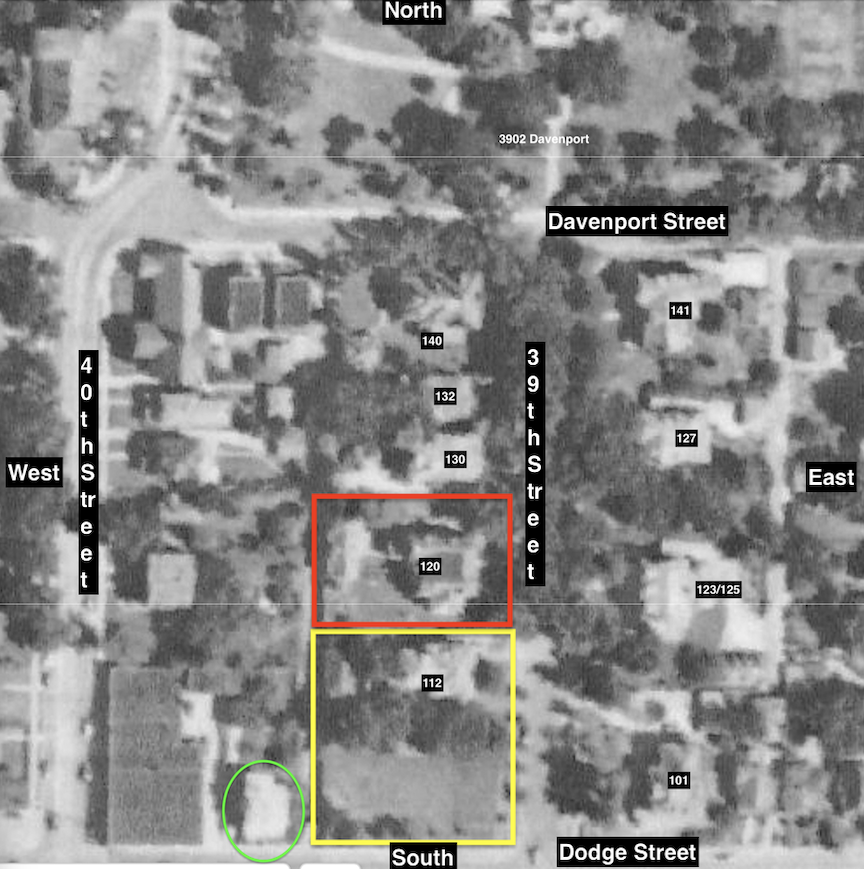
I will explain the fate of the square, rectangle and oval buildings in a bit. But for now, let’s focus on the addresses and building footprints of North 39th Street that still stand. At the time of this 1941 aerial, previous to the TraveLodge’s inception, there were nine total houses lining the North 39th Street Nob Hill—ten if you count the Joslyn Castle at the top of the T.

A favorite Joslyn Castle postcard, possibly because the residence was so obscured. Although an honest portrait at that time, how was this photograph postcard worthy? Alas, I had to buy it for that very reason!
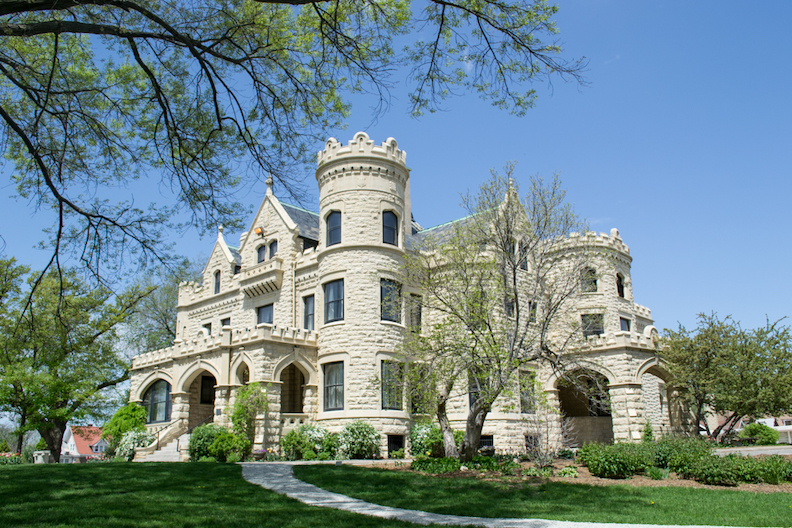
3902 Davenport Street, was Lynhurst, home of George and Sarah Joslyn. Lynhurst is also called Joslyn Castle. Completed in 1903, It is located at the northernmost point of this blockfront of our examination. Might I recommend the exceptional The Joslyns of Lynhurst by Daniel Kiper for more details.
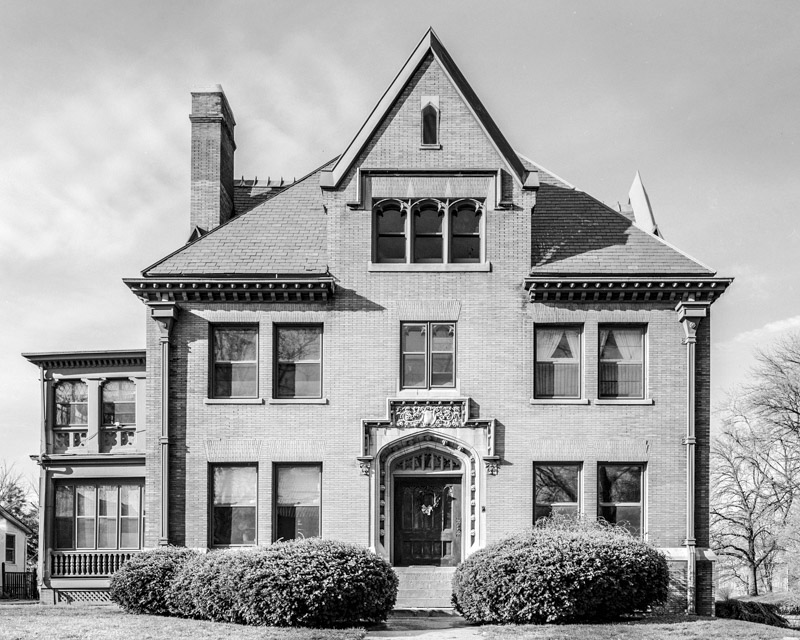
140 North 39th Street, is on the northwestern end of the block, kitty-corner to the Joslyn Castle. Incredible Lynn Meyer photograph from 1984. The Charles and Bertha Offutt house, also known as the Yost-Offutt house or the Offutt Manor, Designed by H. Cobb, this incredible structure was built in 1894. I have written an extensive history of this residence, turned bed and breakfast in the previous links. Here is your open doorway…Bertha Yost Offutt and the Mysterious Gold Coast Mansion
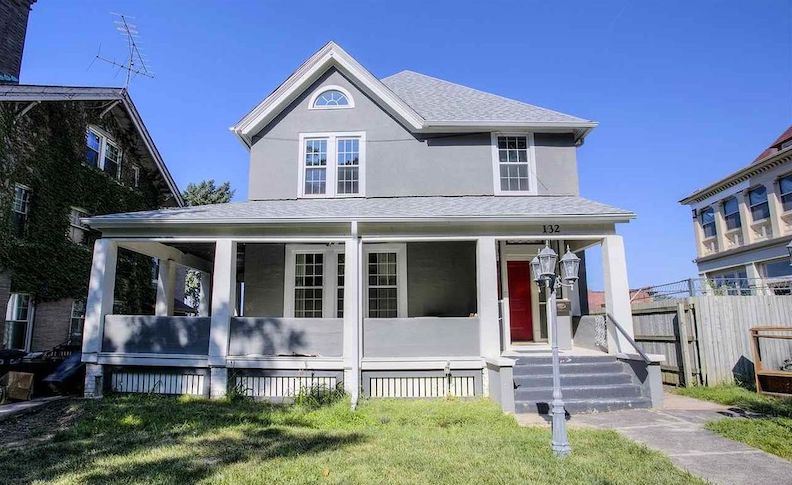
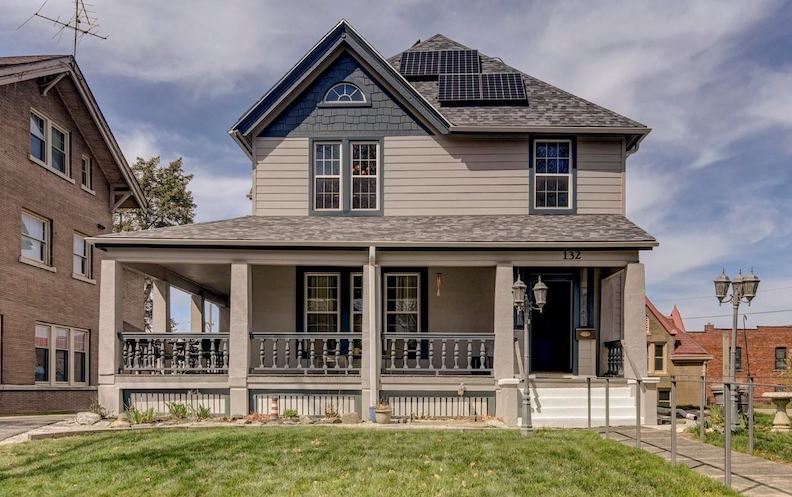
132 North 39th Street, (before and after photographs of recent rehab) directly south of the Offutt Manor, was constructed in the 19th century and is quite possibly the oldest gal on the block. If you perceive vague Victorian features, the shell remains of what was once an intriguing house. This was the residence of Judge W. C. Ives, a distinguished attorney in the area. I contend that Judge Ives was referred to as “Judge” as a moniker, although possibly not an actual judge. His wife’s parents also lived in the large home, as the Ives couple had no children. Judge’s father-in-law Sidney E. Locke, originator of the Omaha waterworks system in 1880, died in this house in 1899. Helen Locke, mother-in-law, passed away in the residence in 1903. Several months later, Judge W. C. Ives passes away in the residence. Charles B. Horton, superintendent of the Western Union, purchased the Ives’ residence and subsequently died there in 1906. Miss Lena Schiffabauer, a 34-year-old live-in domestic servant employed by the Robert Cowell family, was discovered deceased in her bed with the gas heater connection disengaged. Then owner Robert Cowell, former president of the Thomas Kilpatrick Company, succumbed of cancer in this residence in 1924. We may be able to sustain this death saga throughout the night if we all had the ambition. Let it be known, this is a unique residence. Recent owners have tried to rehabilitate the home.
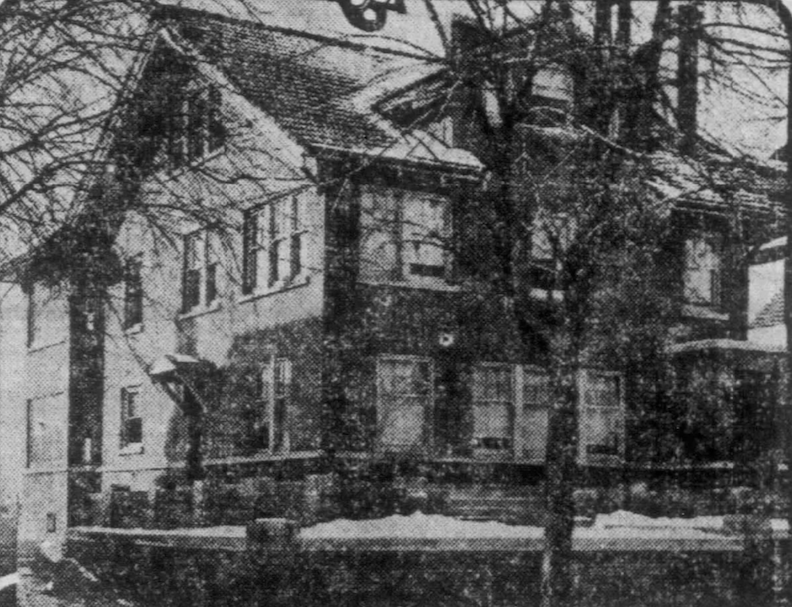

Above is from Omaha Daily News. 1914. Below is how 130 North 39th Street appears today.
130 North 39th Street. The Halleck Fruit Rose residence built in September of 1914. A portion of this parcel was the once Eugene A. Mills home, destroyed in the tornado of 1913. Perhaps that is why this building is listed with the city as being constructed in 1900. Twas not. With 18 rooms and 4,590 sqft of floor space, this is a proper home befitting Mr. Rose, a prominent attorney. This gorgeous girl was built of Roman pressed brick and Bedford stone. Reported at the construction date to have ten formal rooms, “the basement and attic were both well finished,” unusual at the time. The first floor was finished in mahogany with the dining room finished in French grey oak. The upstairs boasted white enamel, oak and mahogany. Mr. Rose died in his residence. Interestingly he was behind the syndicate that erected the Rose building at 16th and Farnam in 1914, later selling to the Guarantee Securities company in 1917; the building’s name was then changed to Securities building. For more details check out: The Case of Napiers Booterie and the Securities Building. Edgar Brainard and his family relocated to the 130 North 39th Street house next. Brainard served as the chairman of the house committee and manager of the Elks Game Room, and was president of the Carter Lake Club. Brainard also passed away in the residence in 1956. This is a special building.
Given the age of these residences and our cultural preference of the past to care for our ill and dying families in familiar surroundings, it was inevitable that there would be a higher incidence of deaths at home. Indeed, the incidence of fatalities in the homes of this block were substantial. Three residences on this block, to my knowledge, are believed to possess charm, possibly more.
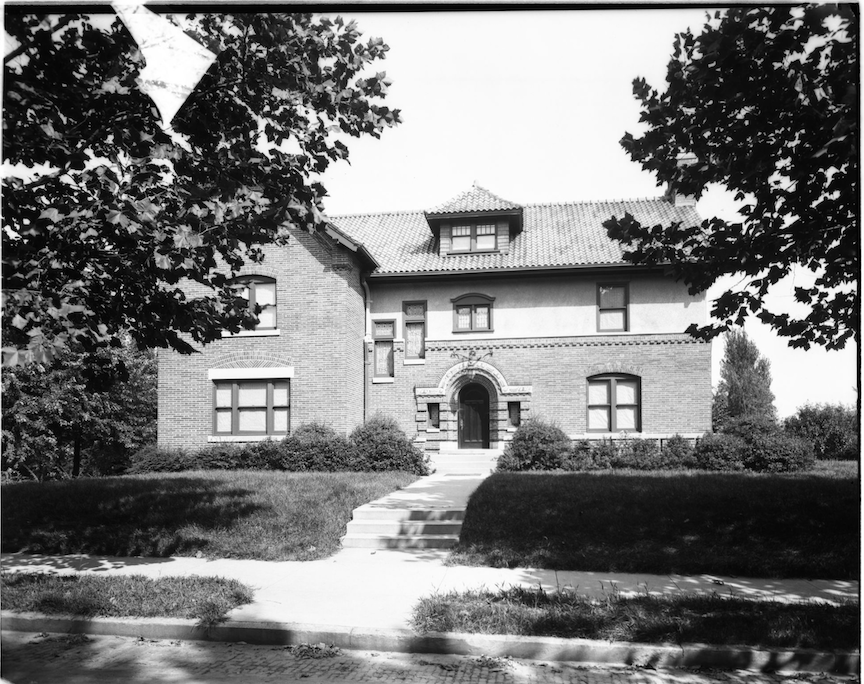
And don’t forget my favorite on the block: 141 North 39th Street, southeast of the Joslyn Castle. The Joseph M. Baldridge house is said to have been constructed in 1911. Glorious Thunder, what a beaut! I’ve wondered if 141 was truly built in 1912, due to the language of an early Mr. Baldridge interview about his 1913 water bill being exposed as the most costly in all of Omaha. 141 North 39th Street. Bostwick, Louis (1868-1943) and Frohardt, Homer (1885-1972). The Durham Museum. 1920.
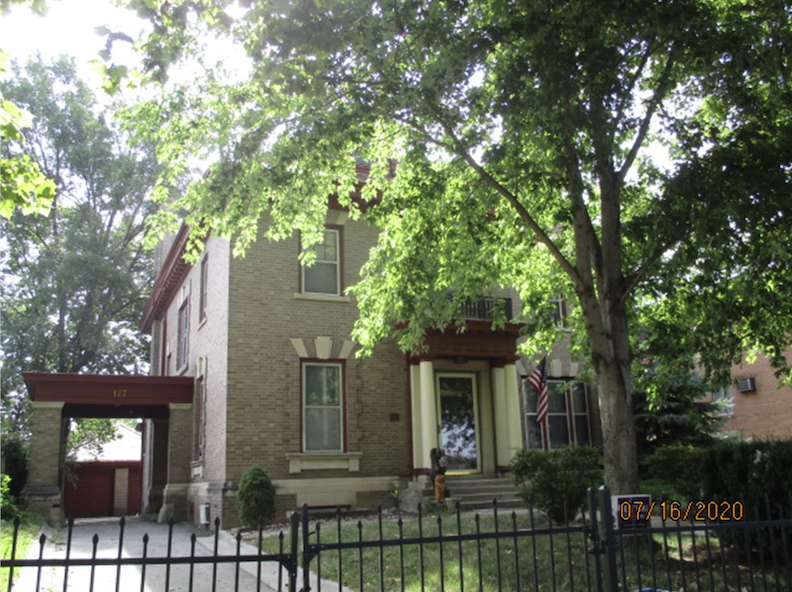
127 North 39th Street is a stately, upright residence. This was the Milton T. Barlow house, president of the United States National Bank. Died in the home of his design in 1930. I believe this home, like others on the block, were refashioned into apartments in the 1940s or 1950s.
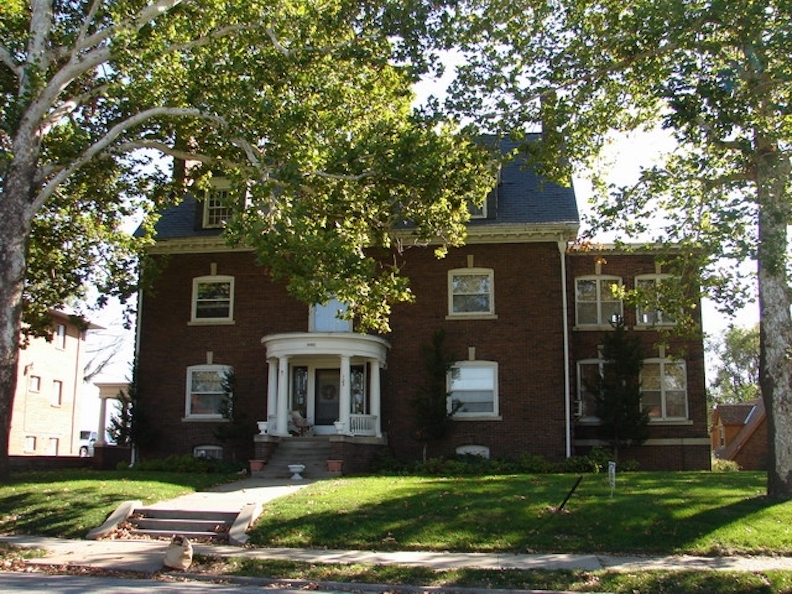
123 North 39th Street was the renowned Millard home. Looks are deceiving from street side; this home extends on the backside. Throughout its history, the addresses 123 and 125 North 39th were used interchangeably for the Willard Barrows Millard residence, perhaps a foreshadowing of what was to come. After a very public divorce in 1911, Mrs. Frances “Frankie” Barton Millard and her children continued to live in this residence. Frankie was daughter of the late Guy C. Barton and daughter in law of Joseph H. Millard, former U. S. Senator for Nebraska. A considerable fuss was made around this substantial brick residence, perhaps because of the famed owners. The reception hall, living room, and dining room were reported to have a mahogany finish; the music room was enameled white, and the sunroom, with southern exposure, had quartered oak and mahogany finishes. Five bedrooms and two sleeping porches, exquisite quarter-sawn flooring with three bathrooms, all were located on the second floor. Two maids’ quarters, a bathroom, a billiard room, and a trunk room are located on the third level. Four-car, heated garage (!). The porte-cochère. 123 North survived the 1913 tornado and lived to tell the tale, but the lady of the manor would not be so lucky. Unfortunately, Frankie died at age 50 of septic poisoning in the home she shared with three of her children. Her death came a few days after her brother K. C. Barton’s death in 1913.
For more on the Bartons and Millards, check out my previous investigation: Mysteries of Omaha: 2226 Howard Street.
After the early 1950s deaths of subsequent owners, Mr. and Mrs. Talley, the massive 125 Millard home was also dismally split up into rental apartments. By August of 1961, Mrs. N. D. Evangelist (local apartment rental owner) had applied for a building permit for a six-plex, and that action is what brought us the Topper Apartment Building in 1962. The apartment building before us, carrying the address of 125 North 39th Street, was the northern portion of the large Millard parcel.
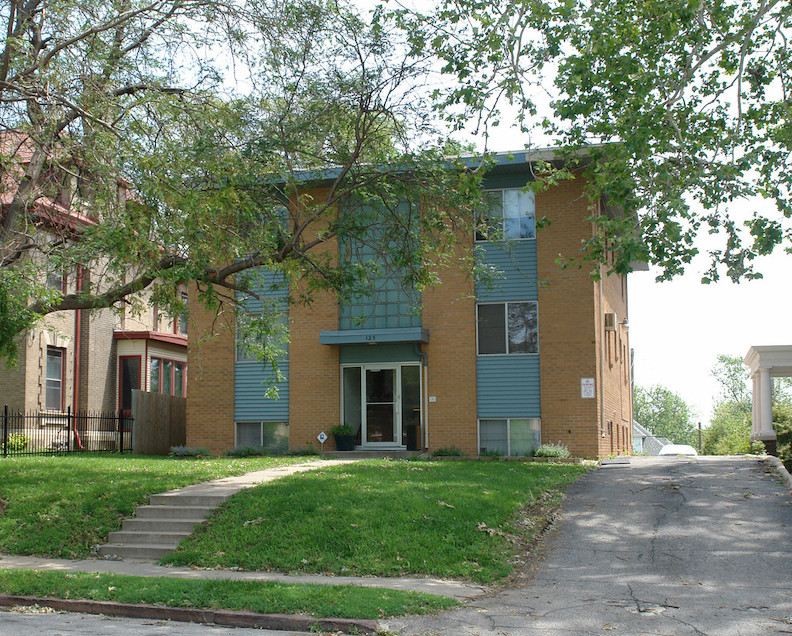
125 North 39th Street, was the northern portion of the large Millard parcel. I have always wondered how this MCM building ended up in this space.
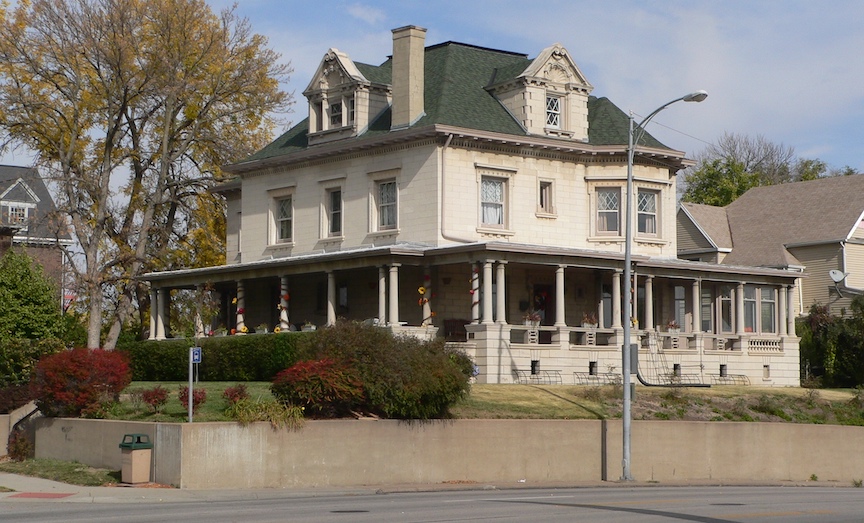
Included on the short block is the Havens–Page House, alternatively referred to as the T. C. Havens House, located at 101 North 39th Street. The front door faces 39th but the massive porch wraps around Dodge as well. Designed by architects F.A. Henninger and J. Harte, this residence was constructed in 1900 for Thomas Collins Havens on the southeast corner of this block. The Walter Page family later took ownership. In 1904 the Omaha Daily Bee labeled the Havens’ home an “English Renaissance style (…) bearing a strong resemblance to the Colonial (…) Here the veranda almost surrounds the house, giving it a very distinguished as well as inviting appearance.” What intrigues me is the high positioning of 101 North 39th Street. I would come to find that the TraveLodge company had to carve away their newly purchased lot to the west. The home on the parcel was described to stand head and shoulders above Dodge—probably much like the Havens house.
I do hope that I have visually laid a foundation and have given some context to North 39th Street, previous to this TraveLodge acquisition. Let’s carry on, as it only gets more muzzy and weird.
The Cornish Move
This business with North 39th and a series of family transactions were hazy at best. I will endeavor to present this as clearly as possible. Let us review our map.

1941 aerial, thanks to the good people at DOGIS. We will now narrow in on that red rectangle and the yellow square.
Joel O’D. Cornish acquired the Charles Henry Pickens’ residence (112 North 39 Street, yellow square) in 1942 when Cornish bought his own exquisite home at 120 North 39th Street (red rectangle), situated to the north of the Pickens’ property. Oddly the Cornishes relocated to 120 North 39th Street from their landmark 1404 South 10th Street home (still standing), which was constructed in the late 1880s by Colonel J. N. Cornish, grandfather of Joel Cornish.
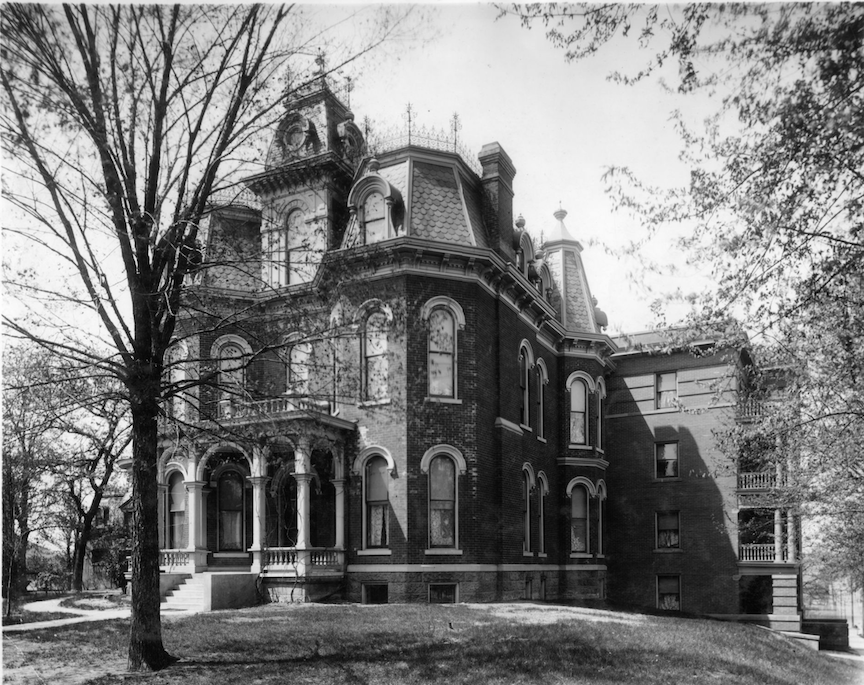
The Cornish mansion on the southwest corner of 10th and Williams Street is an Omaha Architecture Fan (OAF) favorite. The addition at the rear was not original to the building. Now this true mansion is called the Cornish Apartments. Bostwick, Louis (1868-1943) and Frohardt, Homer (1885-1972). The Durham Museum. 1910. Joel O’D. Cornish, wife Marcella and their children moved from this home to our North 39th Street obsession in 1942.
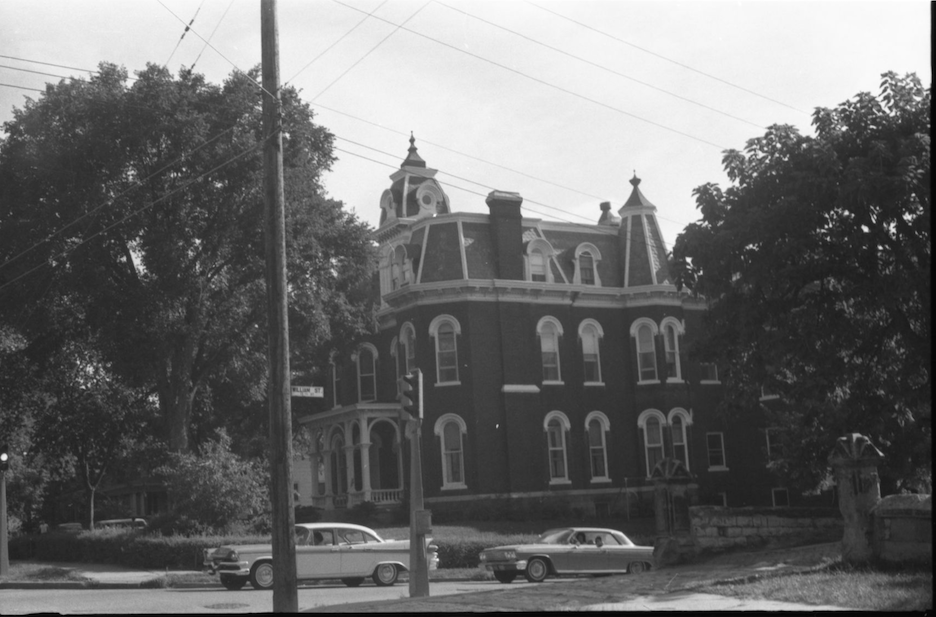
Again we view the Cornish Apartments, 1404 South 10th Street as it looked in 1964. Notice the Curly-Q ironwork has been removed from the roofline. Photographer: Weil, Martin. Durham Museum.
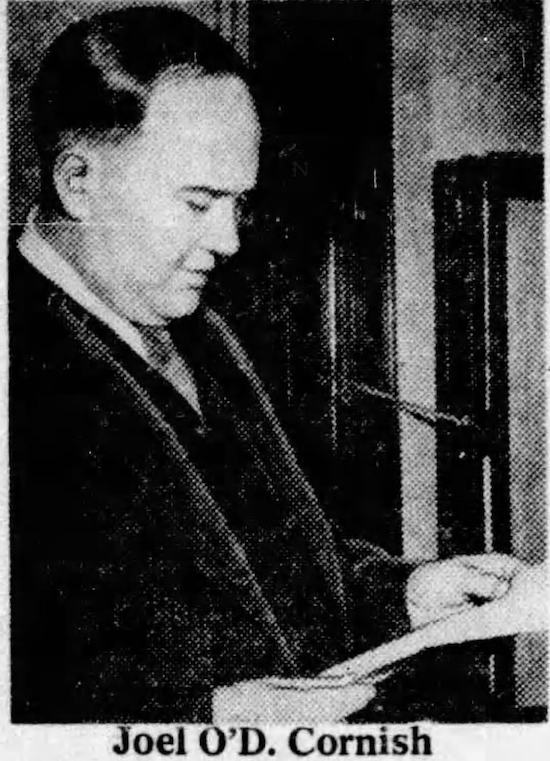
Joel O’D. Cornish was an Omaha attorney, son of Nebraska supreme Court Justice, Albert J. Cornish and the grandson of Joel Northrup Cornish, a notable early settler of Omaha. In 1886 Joel Northrup Cornish built the Cornish mansion at 1404 South 10th Street.
‘Tis hard to imagine what would make a family move from their own grandfather’s namesake mansion, but the Joel Cornishes possibly wanted something more modern, more West O or was it an investment all along? Or all of the above. Or none of those. The following photograph depicts the gorgeous, clean lines of 120 North 39th Street.
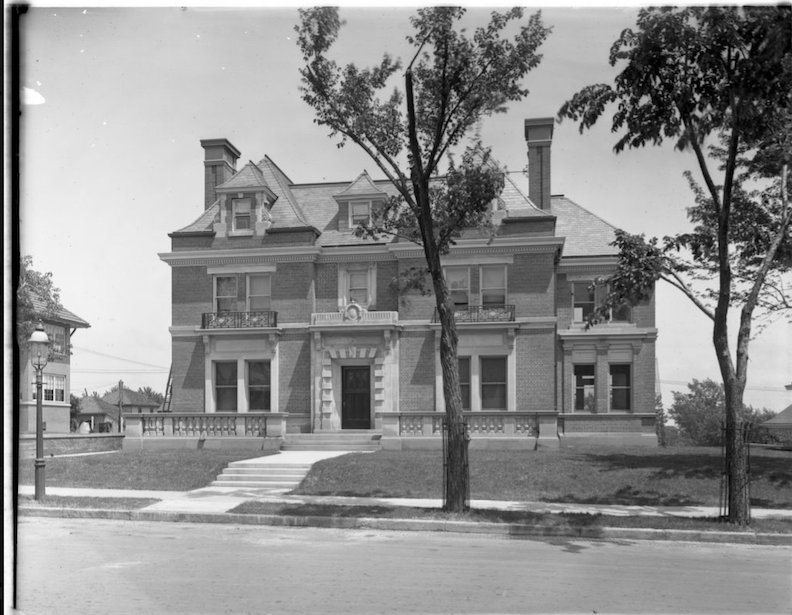
120 North 39th Street (RIP), designed by Architect George Prinz in 1915 was known as the Judge W. D. McHugh residence. Upon completion it cost between 60 and 70 thousand dollars and had some 15 large rooms. The Matthew A. Hall house had stood on this property until the 1913 tornado. William D. McHugh, was born in Galena, Illinois and became a resident of Omaha in 1888. A prominent Omaha lawyer, McHugh was appointed a federal judge by President Cleveland in 1896, however this was not confirmed. “Judge” McHugh was offered a job in Chicago as general counsel for the International Harvester company that led him to selling his gorgeous home in 1919. The Folda family purchased the home in 1919. Englebert F. Folda organized the Banking House of F. Folda, was president of the Stockyards National Bank and the Nebraska State Bankers Association. The Foldas moved to Los Angeles and later sold in 1926 to Dr. Anton Kani, who surprisingly converted this residence into a hospital clinic for his osteopathic practice. It is reported that Dr. Kani increased the number of rooms to more than 20 for his clinic.
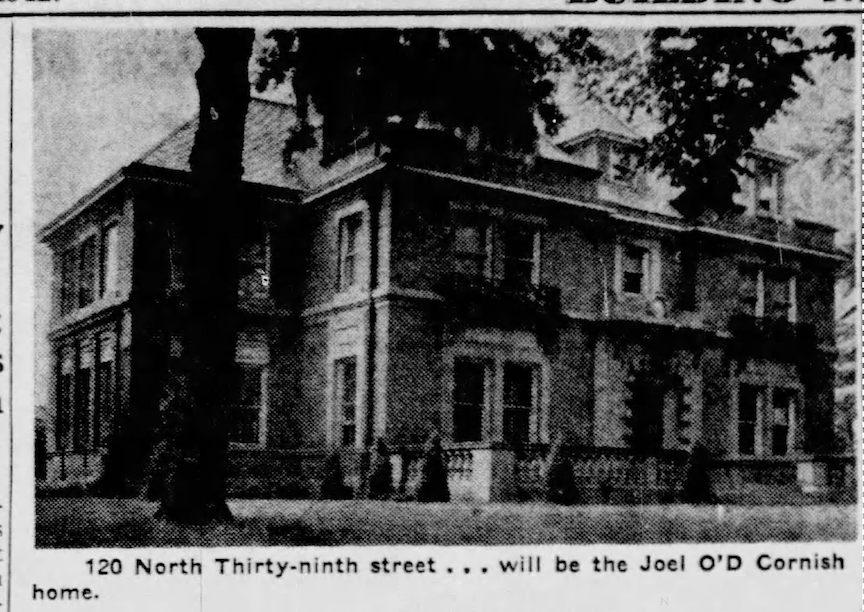
Omaha World-Herald. June 1942. The Cornish family planned to take out the partitions that Dr. Kani added and return the large house to its original, formal arrangement.
The Pickens Property and the 1913 Tornado
Charles Henry Pickens was once a prominent business leader, president of Paxton & Gallagher, wholesale grocers of Omaha and an early Ak-Sar-Ben King. To further complicate the storyline, the original Pickens home, at the same 112 North 39th Street address, was razed to the ground after significant tornado damage from the famous 1913 twister. Examination by Mr. Picken’s architects revealed the home repair was impossible. I dated the original Pickens home back to the late 1800s.
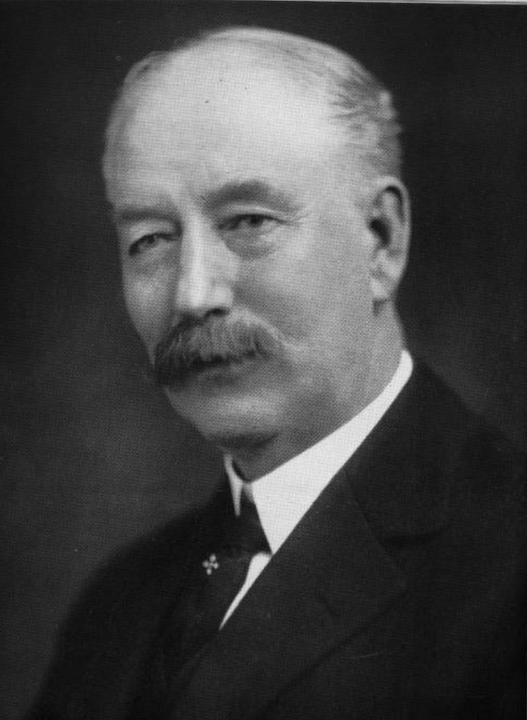
Charles Henry Pickens.
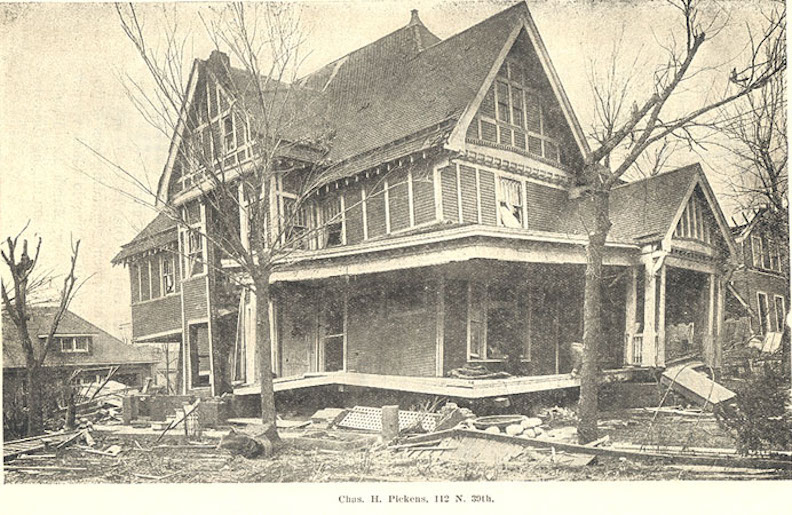
The first Charles Henry Pickens home at 112 North 39th Street. View of the Matthew A. Hall house to the north (right side of photo.)
In April 1913, the newspapers reported that the families of North 39th Street, whose residences had been demolished in the recent tornado, were in the process of reconstruction and renovation.
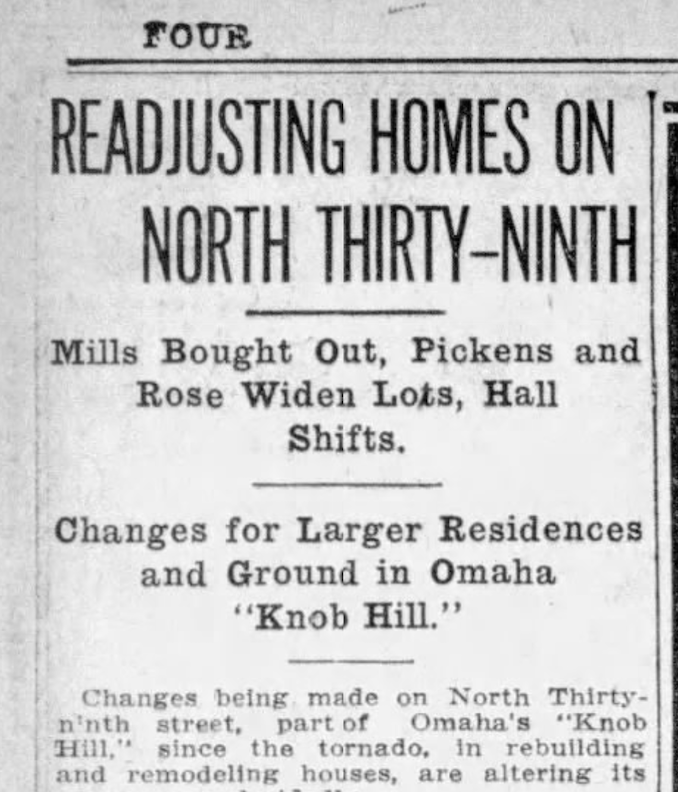
April 26, 1913. OWH.
This article shed light on prior inconsistencies and medley of confusing names. The property owned by Eugene A. Mills at 120 North 39th was purchased with the intention of expanding the future planned residences of Charles H. Pickens and his neighbor, Halleck Rose, (mentioned earlier). M. A. Hall, a British vice counsul, was scheduled to “shift” his home “a little north to oblige his neighbors” but was thought to retain his ninety-foot front. Hall’s residence was “practically” dismantled by the tornado without any formal rebuilding plans. The more I dug for clues, Hall’s rebuild never seemed to have materialized.
Another article from September of 1913 illuminated the Hall information. Judge. W. D. McHugh purchased M. A. Hall’s vacant property for “one of the highest prices ever paid for residence property in Omaha.” McHugh’s house, as we have seen, would abut C. H. Pickens’ on the north.
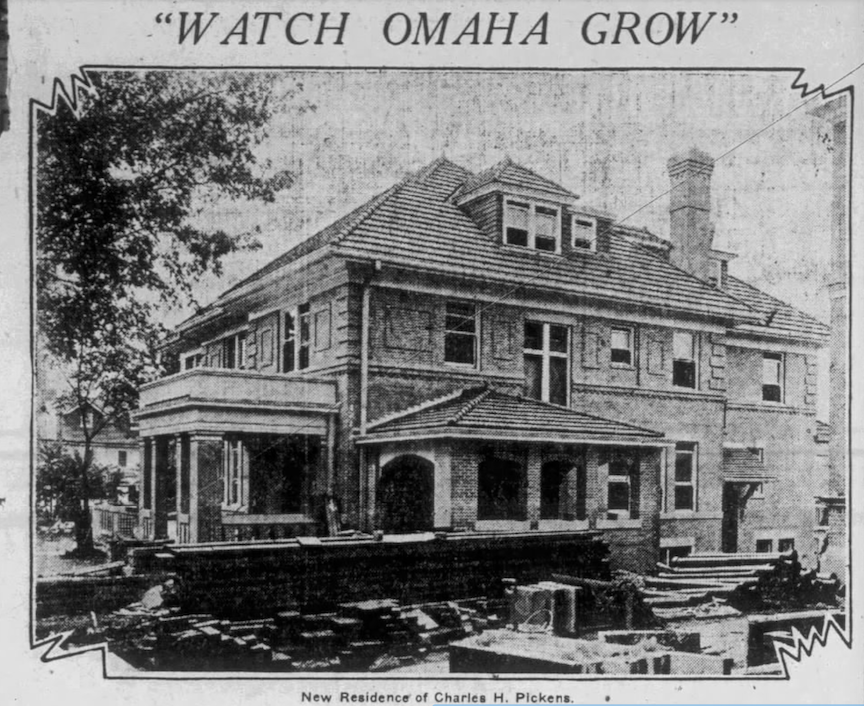
October of 1914. OWH. The new residence of Charles H. Pickens at 112 North 39th Street. Another stunner.
The Pickens family relocated to 117 North 40th Street until the construction of their new 112 North 39th Street home was finished in 1914. The Pickens property was made up of two parcels of land; the home itself was situated toward the north of the two expansive lots, as seen from the aerial.
Further examination of these odd circumstances revealed that Mr. Pickens donated a ten room house, destroyed by the tornado, to a Reverend A. J. Barber, who would use the materials in building a new church between 32nd and 33rd on Burt Street. “Mr. Pickens bought the property for a lawn for his residence, next door. The house itself he gave to Rev. Mr. Barber.” I’ve got to think the Pickens had the Reverend Barber remove the once Eugene A. Mills house as a “donation.”
Reportedly a “massive” home with twelve formal rooms, Mr. Pickens, a very wealthy man, downplayed this new display, stating he wanted the home to be comfortable–not extravagant.
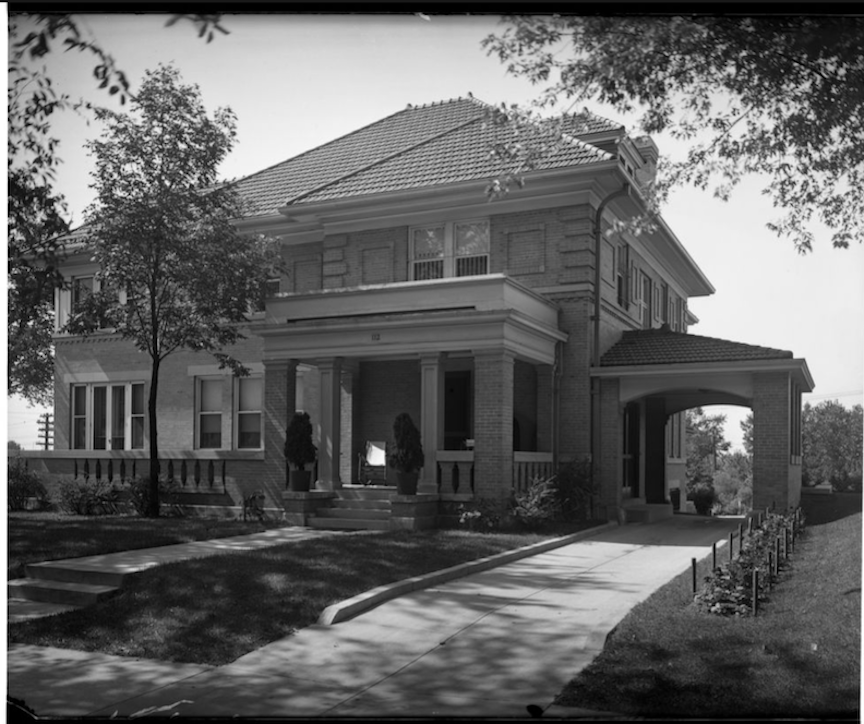
The end result: Divine. Do we all envision a green tile roof? Exterior view of the Charles Pickens, President of Paxton & Gallagher Company, house at 112 North 39 Street. (RIP) This is the home in the yellow square seen on the previous map. Yes, we live for our porte-cochères around here. Bostwick, Louis (1868-1943) and Frohardt, Homer (1885-1972). 1916.
112 North 39th Street
I think we all can agree that the Pickens 112 North 39th was an aesthetically pleasing structure. As is distressingly customary around these parts, by 1960 this handsome brick house “had known finer years,” according to the press. Perhaps it was true. I was not around to protest, let alone alive yet, but I found it odd that all parties involved seemed delighted to call this gracious Gold Coast beauty, “aged.” I have learned in all these years of research that the 1950s and 1960s were terribly hard on Old Omaha. The attitudes in the mid century, in particular, did our architecture in. It sometimes appeared that after World War II, Omaha yearned to become a big, modern city– so eager to tear down the finery of the later 19th and early 20th Centuries because the structures had fallen from fashion. But who’s crabby today? I am.
What in the heck happened to 112 North 39th Street? As best I could find: Charles Pickens died at age 67 in his 112 North 39th Street home in 1923. Mrs. Pickens subsequently passed away in 1929. The Pickens’ daughter, Mrs. Kenneth Patterson, then inherited the residence. Following the death of Kenneth Patterson in 1934, the widow resided there with their children until she relocated to the Ambassador Apartments in 1936. Mr. and Mrs. Myles Standish moved in and then out in the 1940s.
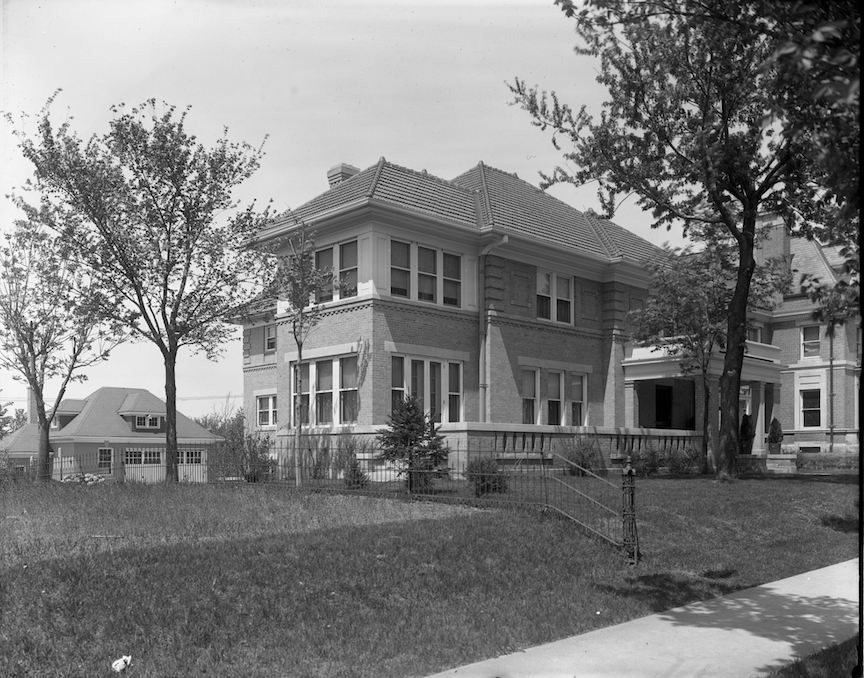
The salad days–the Pickens home at 112 North 39th Street with their garage behind. Judge McHugh’s at 120 North 39th Street to the north (far right of photograph). Bostwick, Louis (1868-1943) and Frohardt, Homer (1885-1972). 1915. South of the Pickens was their large garden area.
When Joel Cornish purchased 120 North 39th Street and the adjacent Pickens home at 112 North 39th in 1942, both properties were regarded as exemplary, located in a prestigious neighborhood. Following Cornish’s acquisition of the Pickens home, he listed the residence for rental in January 1943. A succession of respectable families rented the house but by the early 1950s the Morals Squad was all over the 112 North 39th Street house and arrested two women for prostitution. That seemed to signify the beginning of the end. This scandal appeared to align on the timeline with the transformation of other substantial residences on the block into rental properties and their conversion into multi-apartment complexes. B. F. Sylvester lamentably reported in her chapter titled “Changing Times” from the 1964 publication, West Farnam Story, that the “Offutt home has officially become apartments.” From single-family residences to multi-family dwellings….was it a financial inevitability with homes this large and expensive to upkeep? Regrettably, several residences in the Gold Coast that could not shift to commercial use or apartments were razed.
Also we must take into account that City Planning was most certainly eyeing Dodge Street for its potential as an increasing commercial thoroughfare. If we peer down at 40th and Dodge, even in the 1940s, this was a place of business, one block away.
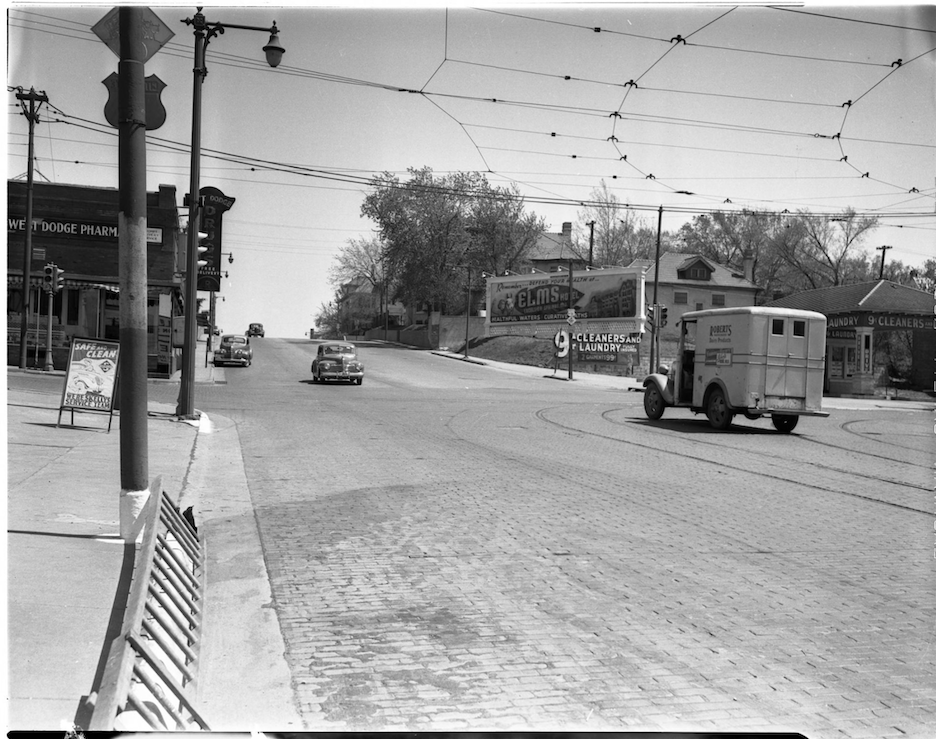
Looking east uphill at 40th and Dodge Street. The West Dodge Pharmacy is on the left. A billboard is seen on the south east corner next to some kind of laundry. Wentworth, William (1892-1982). The Durham Museum. 1943.
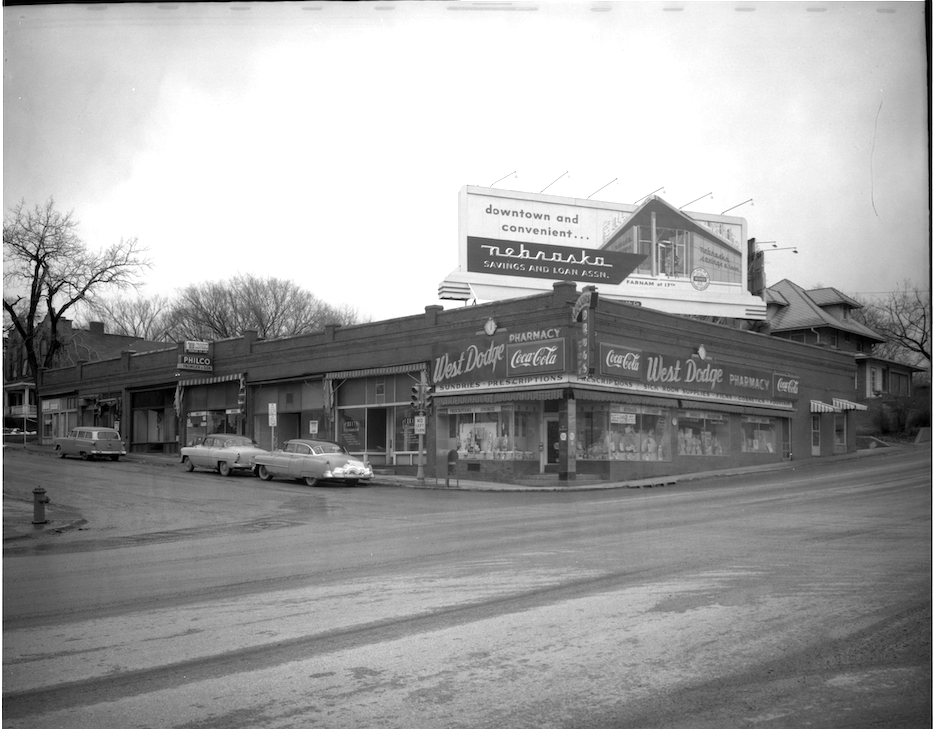
Another angle, looking northeast at the West Dodge Pharmacy at 40th and Dodge. Just take me back, please. Look at all of those great little shops running along 40th Street. Bostwick, Louis (1868-1943) and Frohardt, Homer (1885-1972). The Durham Museum. 1958.
By the way, since we are here, directly east of the West Dodge Pharmacy and exactly west of the Pickens residence was a very cute American Four Square home. I had signified its existence earlier on the aerial map by way of a green oval. This place fascinates me.
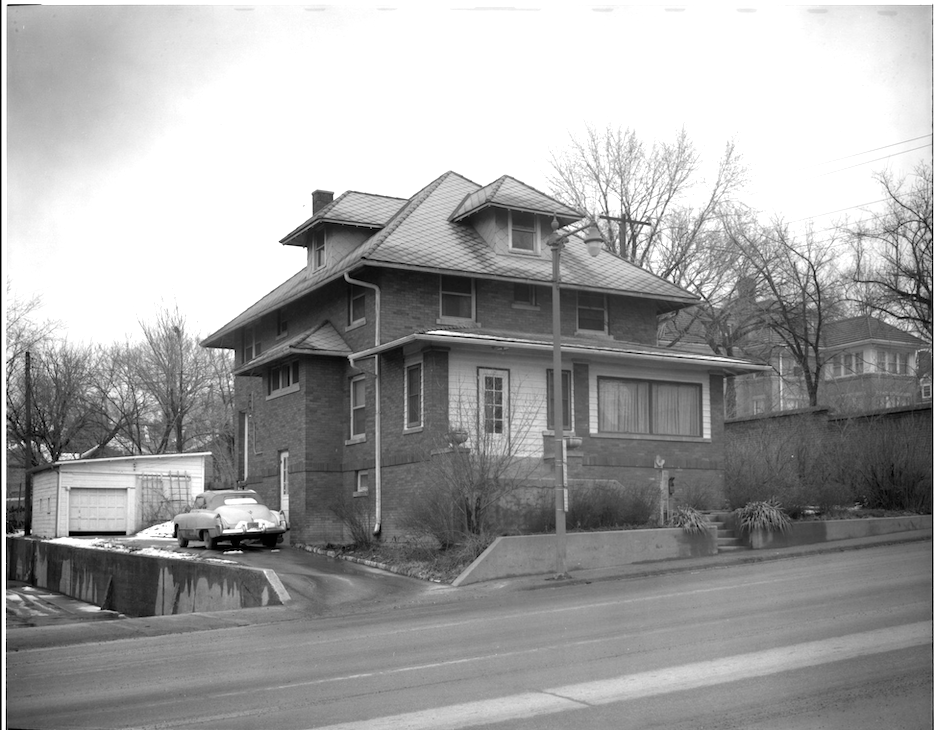
Looking at a house on the north side of Dodge Street just east of 40th Street, just west of 39th Street. It is a two story house with a driveway and garage on the west side. A car is parked in the driveway. I looked like it had a large porch, then closed in, at one time. Bostwick, Louis (1868-1943) and Frohardt, Homer (1885-1972). The Durham Museum. 1958. Directly east of the house is tall embankment wall and the Pickens home in the distance. We had learned the Pickens parcel was above Dodge and this is our visual proof. This Dodge Street Four Square would be taken out to make way for the motel later.
Strange Turn of Events
Joel Cornish died of a heart attack at the age of 55 at his summer home near Lyons, Colorado on August 15th of 1960. Wife Marcella inherited the majority of his wealth. Literally one day after announcement of Cornish’s death, the Pickens house that he sold to TraveLodge was razed.
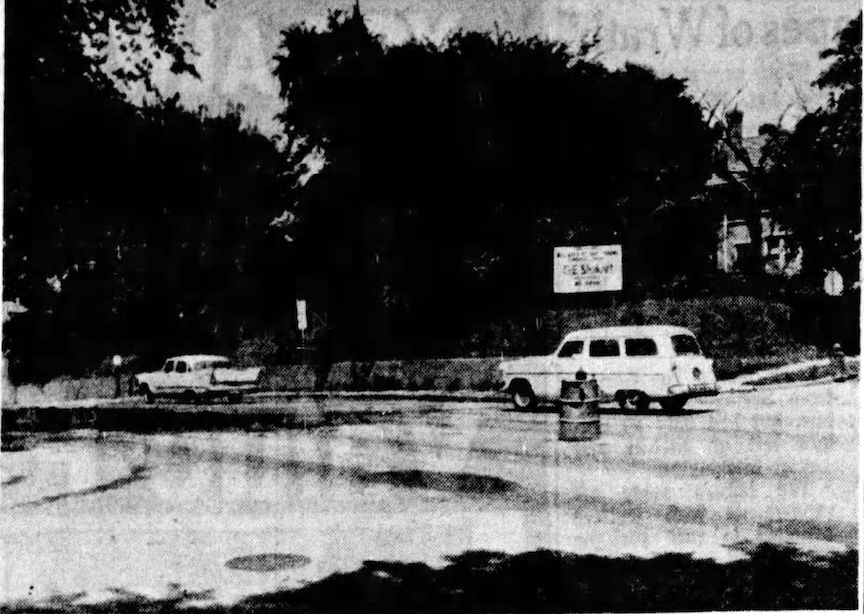
Evening World-Herald. August of 1960. Camera faces northwest angel. Cars drive past the tall Pickens property, home seen in the distance. The article read, “Road repair on Dodge has nothing to do with the construction.” Same old Omaha…we know. We know.
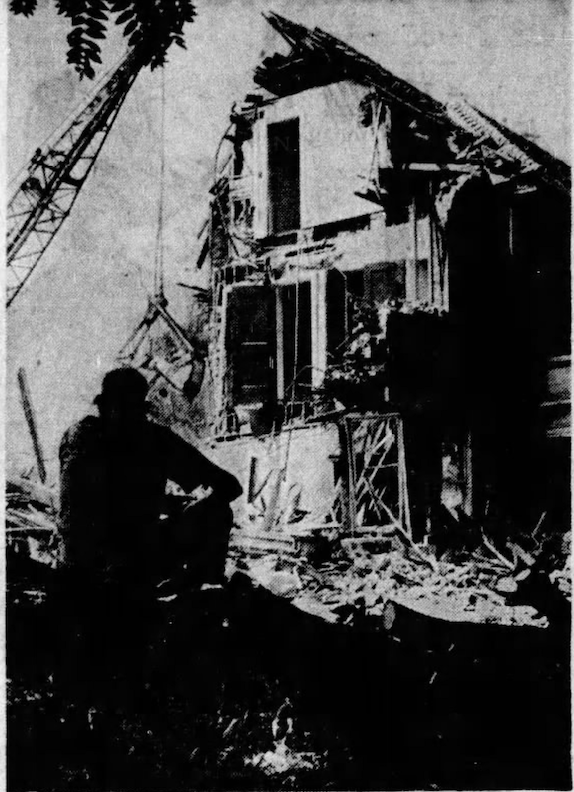
The crane’s clamshell bucket “ripped huge mouthfuls of tile roofing and brick veneer.” Leonard Segal of the wrecking firm said matter of factly, “Nothing would be salvaged.”
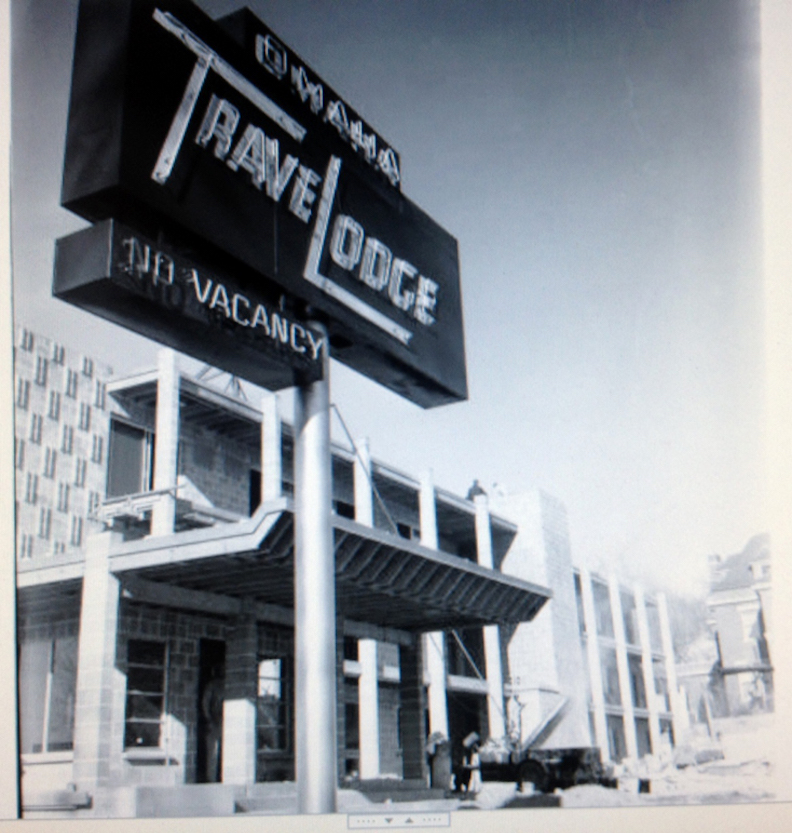
TraveLodge in 1961 before a coffee shot was built. The Cornish home is seen on the north side, in the distance.
In February of 1961 the TraveLodge at 39th and Dodge was completed and they opened their doors for business. Mr. Dale Moorhead was named managing partner. Omahans noted that the building’s shoulder abutted Dodge Street, the “front elevation” actually faced 39th Street. Upon opening day Mr. Moorhead, manager said the plan for the heated outdoor pool was scaped. The official address was 3902 Dodge Street.
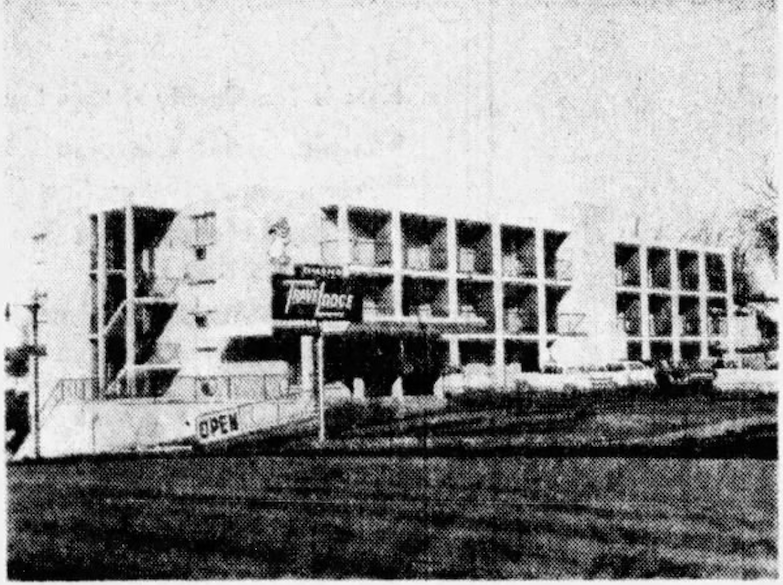
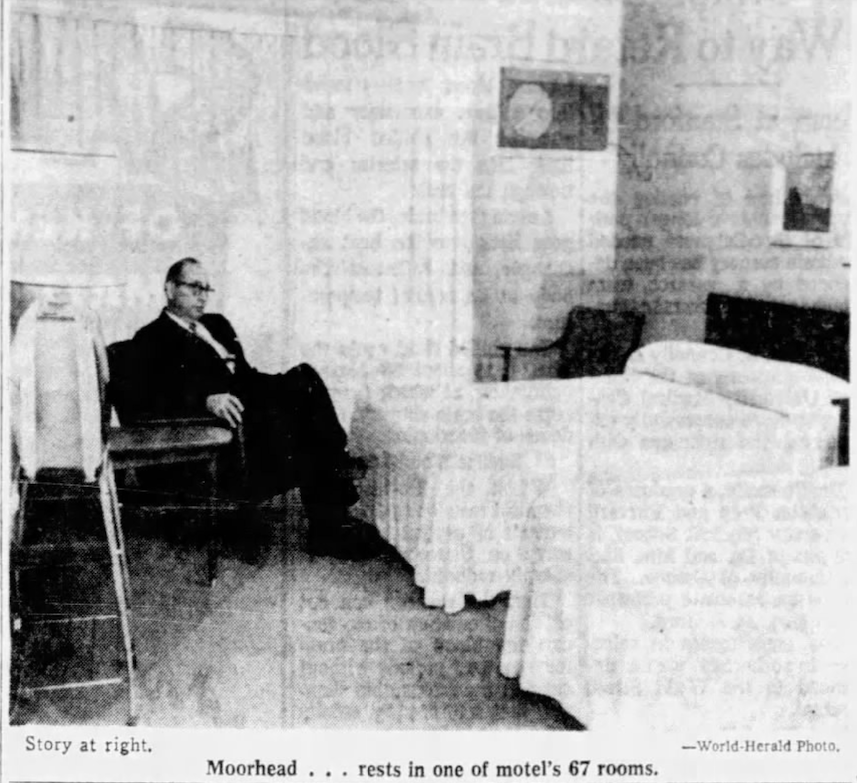
Both photos from Omaha World-Herald, February of 1961.

Another great postcard from the early TraveLodge. This shows the amount of grading completed to bring the property down to street level. The Cornish mansion is seen to the north.
Second Mansion Comes Down
In April of 1962, after Joel Cornish’s sudden death, his widow also sold 120 North 39th Street to the TraveLodge Corporation to make way for a 30-room addition to the motel. The Judge W. D. McHugh residence, designed by George Prinz would be razed. It was reported that Mrs. Marcella G. Cornish, widow of Joel O’D. Cornish, moved out of the gorgeous Georgian house and went to California. In its 47 years it was “one of Omaha’s fine homes,” housed three prominent families and served as a medical clinic. The lot was 150 feet deep with a frontage of one hundred feet. The large carriage house and gardens including a large willow tree, fir, linden and crabapple were being removed. It was all too strange.
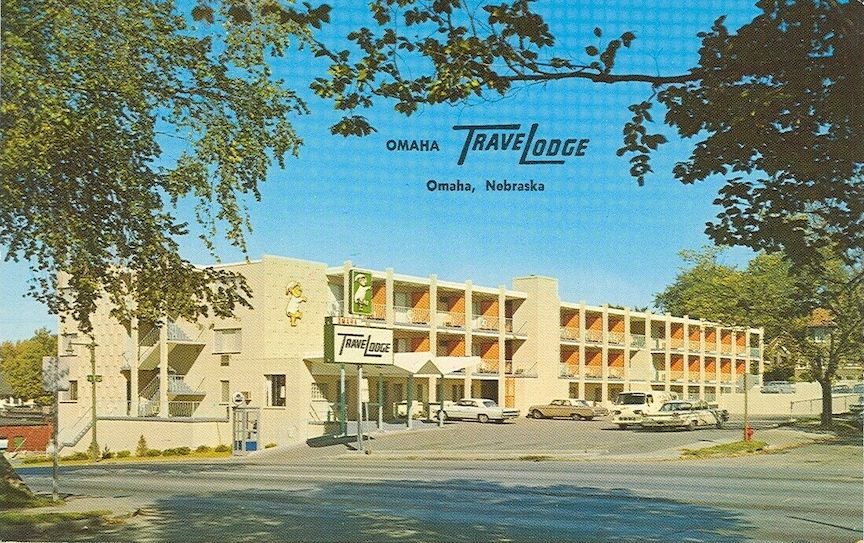
The next postcard I would find on the timeline showed the motel extending further to the north with its newest addition. The TraveLodge parcel then reached the 130 North 39th Street house–once the Halleck Fruit Rose residence. Take note that there is no coffee shop restaurant built yet.
A Few Words on the Toddle House
Many of you might remember the little coffee shop attached to the TraveLodge. The building permit for the Dobbs Toddle House coffee shop located at 108 North 39th Street was submitted in July 1963.
Toddle Houses were an adorable national chain and their building of choice was a tiny, free standing, minimal Cape Cod.
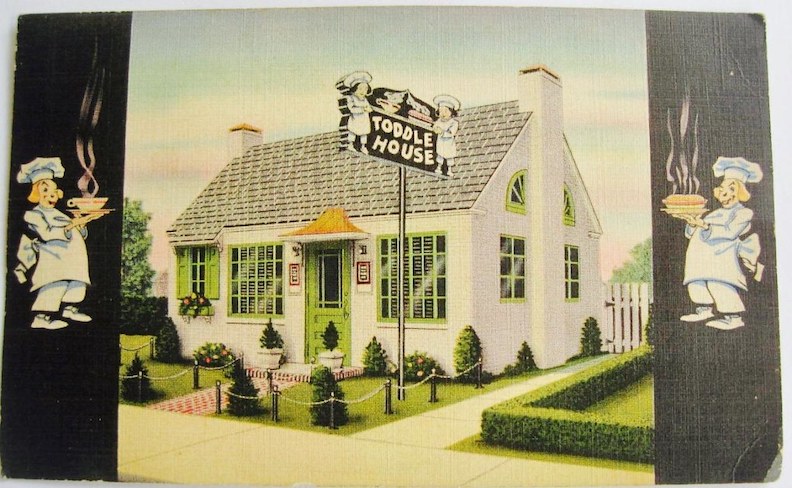
1930s Toddle House postcard.
There seemed to be some mutual relationship with Travelodge and the Toddle House in the late 50s and 1960s. Well, at least in Omaha and Florida. See the Floridian postcard below. In 1962, Toddle House was acquired by Dobbs Houses, a rival that also managed Steak ‘n Egg Kitchen, leading to the Toddle House’s franchise deterioration. I would discover that Omaha’s TraveLodge Toddle House might have hung in until the late 1970s. Then the step-sister franchise, Steak ‘N’ Eggs Kitchen moved in.

The TraveLodge and Toddle House in Florida were much cuter than our Omaha offering. Same basic cinder block idea.

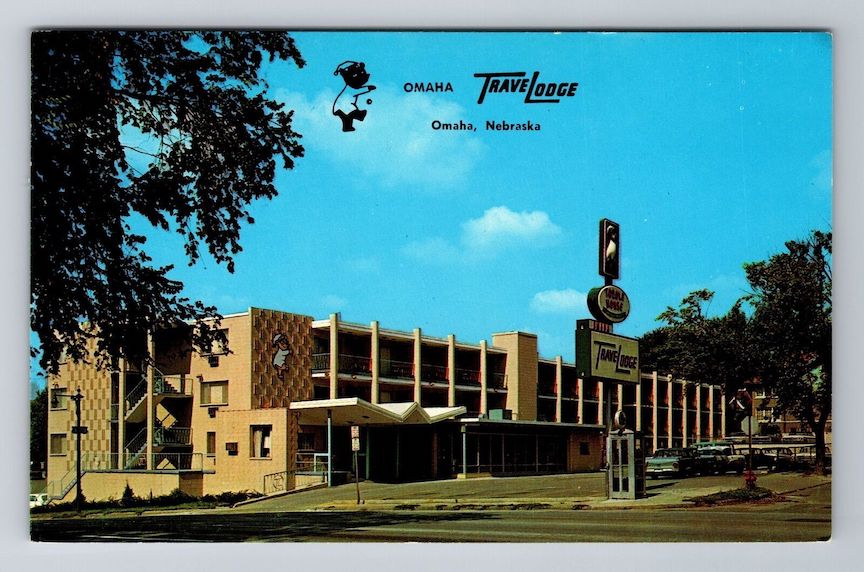
Toddle House arrives and is added to the eastern elevation of the TraveLodge. Consider the addition to the marquee.
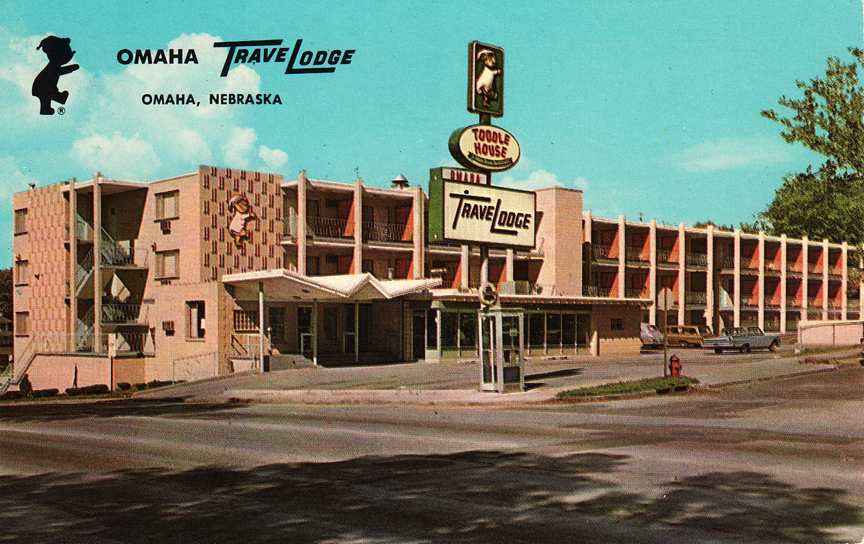
I love all of these various angles and different lighting. Who thought the TraveLodge needed this many postcards? Wonderful.
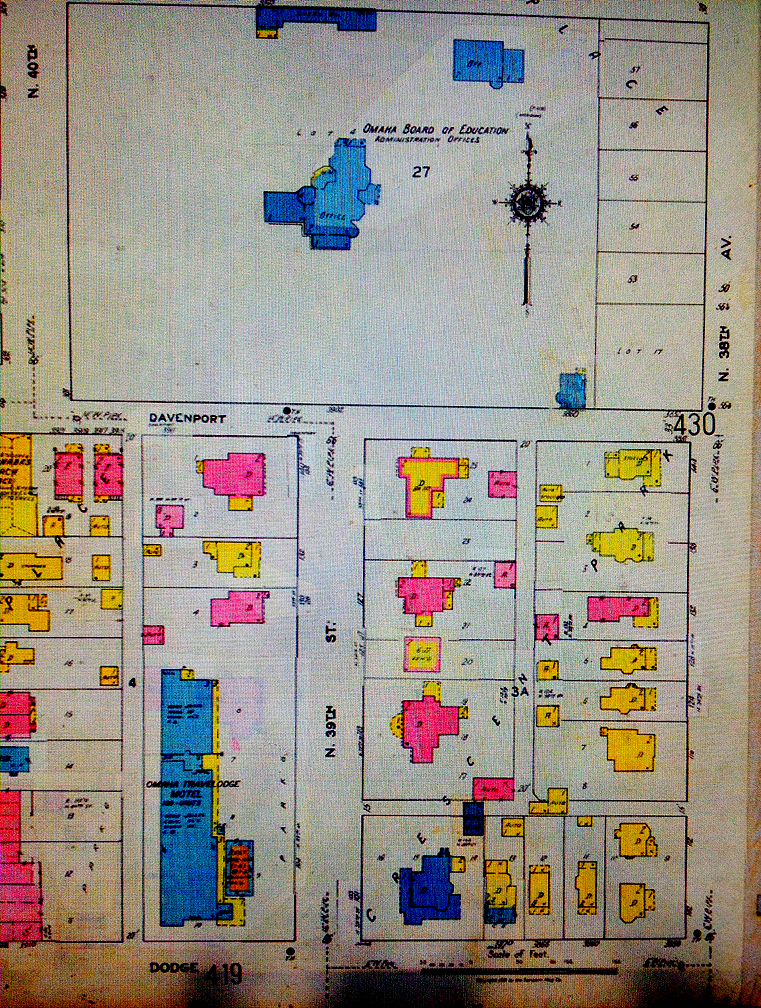
Fascinating Sanborn Map detail after 1962 expansion and the Toddle House addition. The Sanborn map indicates that two mansions were demolished to construct the TraveLodge. Thank you to the Trina Westman, former Omaha City Planning Department staff member, for allowing me to share this map. Also notice the addition of the 125 North 39th Street apartment building to the east side of the street, on the Millard lot.
The Troubles
Things were going fine at the 3902 Dodge Street TraveLodge. Offering inexpensive travel accommodations was and is needed in our city. Because it was a cheap motel, TraveLodge was drawing in a wide range of clientele from the beginning. Their early marketing was geared toward families with children and I don’t disparage this particular company. The problem as I see it, was with city planning. A budget motel or any motel should not have been established in a neighborhood to begin with. Ironically, the primary appeal for a family of tourists in the early 1960s, being able to drive right up to your motel room, became the most harmful factors of motels from a crime prevention perspective. Unrestricted access to rooms enables problematic guests and visitors to enter and exit without detection by motel staff. The problem with a budget motel vs a hotel is that motel lodgers and their guests can directly access the rooms of a motel, rather than having to pass through a lobby of watchful eyes. Supposedly we did not have many motels within city limits at the time. Maybe City Planners or those who gave approval for TraveLodge didn’t understand what could happen. Additionally Omaha did not recognize its limited historic architecture nor place value on this North 39th Street block back in the early 1960s. ((Does it even now, I question?)) For the Cornish family’s part in this, did they only see dollar signs?
The newspaper archives reveal that the troubles began in the mid-1980s. 1985 burglaries, cars in the lot connected to a murder in Florence. TraveLodge televisions, bedspreads, pillows were customarily being stolen. But in 1987 when a California man was arrested with cocaine by narcotics officers after receiving information that he was selling drugs, it was at an all time low, which could and did sink even lower.
Mark Langan’s fascinating More Busting Bad Guys made plain an Omaha police officer’s experience with the notorious TraveLodge. “In the late 1980s Los Angeles gang members were establishing a foothold in Omaha while selling a poison know as crack cocaine. Conducting business like true entrepreneurs, these cunning and dangerous criminals realized that by infiltrating untapped Midwestern cities like Omaha, Denver, Minneapolis and Kansas City, they could double or triple their profits from the street price in California. Crack, a highly addictive form of cocaine, was relatively unknown in Omaha until 1987, when I made my first crack-related arrest in the infamous (and now demolished) Travel Lodge Motel (sic), a spot where the stairwells and elevators smelled like piss during my entire twenty-six year police career. The Travel Lodge (sic) was located at 39th and Dodge and was one of the seediest roadhouses in Omaha. Three floors of prostitutes, infidelity, suicides, drug dealing and general debauchery were all part of the vibe…” Langan continues in his colorful descriptions that this “sleazy” motel was “not a normal place for upstanding out-of-town visitors to stay while visiting Omaha.” He described the ways in which dealers posted up in these TraveLodge rooms with large quantities of drugs; how they used the motel to contact their buyers and make transactions using their pagers in conjunction with the motel room landlines. The OPD could not put a wire on a motel room landline.
Pondering the conditions at the TraveLodge – Travel Inn, I began to understand that the variables and reputation were all- too favorable for committing crimes. 39th and Dodge was a nice, central location to operate from and an inexpensive place too. The motel accepted cash. Low overhead for a dealer. The motel staff did not ask for extensive personal histories of its guest. The criminals could also count on a small staff, barely any oversight, certainly with overnights. Unrestricted parking lot. Another benefit being that half the rooms had a straight shot view out into the parking lot. Other guests were temporary themselves, so why report to the authorities and get pulled into anything?
The local newspapers also let on that by June of 1988 The Travel Inn, another budget motel franchise, had purchased TraveLodge. A lodger from Fremont was robbed at gunpoint a month after. The Travel Inn’s promotional strategy included providing accommodations at a rate of $100 per week and monthly rates as well–access to a kitchenette, a telephone, television, bath. In 1994 the body of a murdered taxi driver was found in the parking lot. By 1996 a woman was murdered while she and two men were buying crack. All of these things verified for me why I had been avoiding the corner motel in the 1990s.
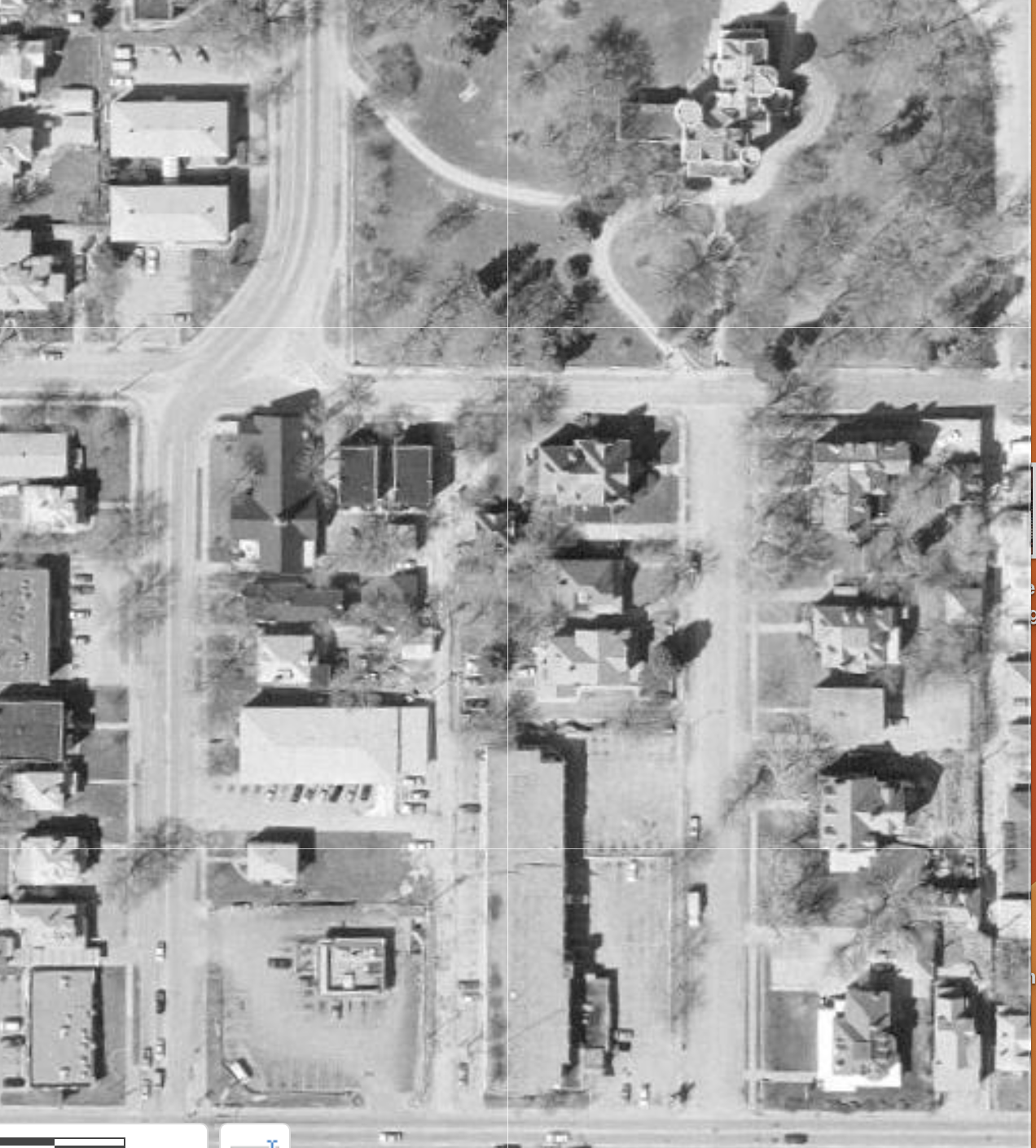
1993 aerial of The Travel Inn and surrounding area. Image borrowed from DOGIS.
Omaha’s incredible Saigon Restaurant moved into the former Steak ‘N’ Egg site in 1993. As news of their exceptional cuisine circulated, the Saigon began attracting Vietnamese food enthusiasts to that sticky web of the Travel Inn parking lot. This was a dicey affair. When the Saigon’s cash register, slicer, grinder, computer system, fax machine and four cartons of cigarettes were stolen from within the beloved restaurant, the writing was on the wall. It could have been presumed that they would depart. But no….they bravely stayed on. Then the rule became we would only eat there in the day. I remember dining at the Saigon with Mr. Cassette early in the 2000s and I would also go with my girlfriend, who was Vietnamese American and she would decode the kitchen gossip over our meals. The Saigon moved out west to 12100 West Center Road shortly after.
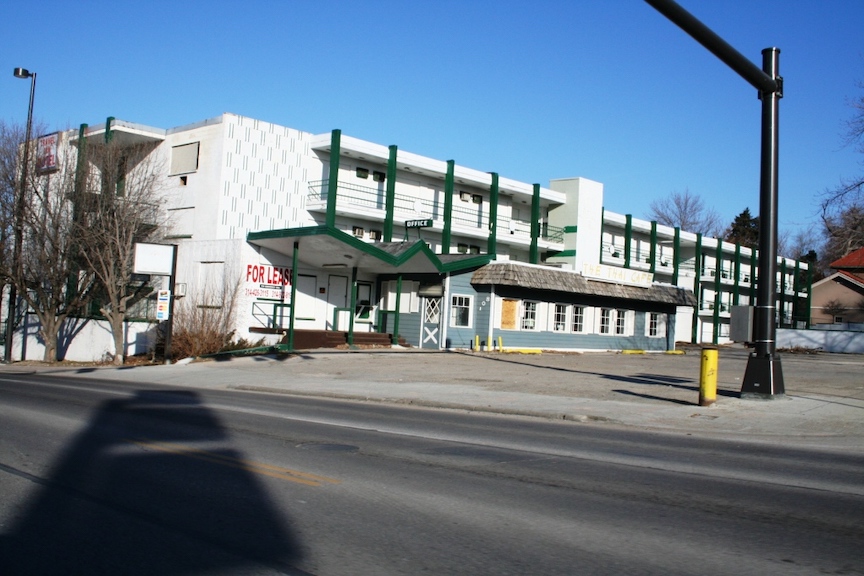
Travel Inn For Lease.
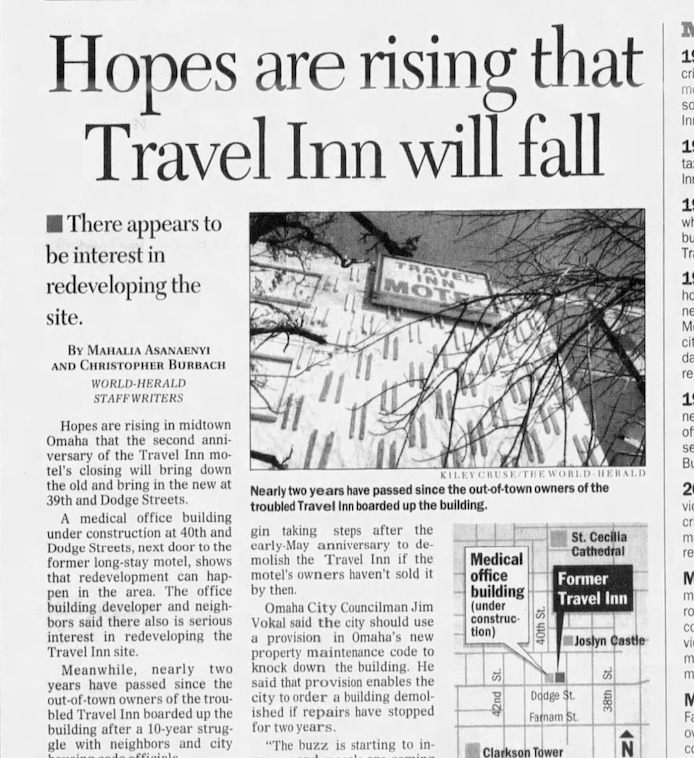
Omaha World-Herald. 2006.
By the late 1990s, the neighborhood had assembled collectively and was exerting much needed pressure on the City of Omaha. The proprietors of the Travel Inn, who resided outside Omaha, would delegate their poorly paid managers to address the irate public during meetings. Following several code violations and persistent criminal activity at the motel, the city attempted to punish the motel managers for neglecting necessary repairs. The city and its neighbors would repeatedly suffer defeat. The proprietors of the Travel Inn shuttered the motel and formally secured it following the murder of another individual in his room in May 2004. The Joslyn Castle Neighborhood Association witnessed the closure to the conclusion. The demolition of the Travel Inn was completed in June 2006.
Although this was a good razing, it is sickening to think that this solitary motel obstructed adjacent economic redevelopment, tarnished the reputation of the formerly esteemed North 39th Street, and adversely affected homeowners’ capacity to lease or attract prospective buyers for decades.
The Empty Lot and New Building
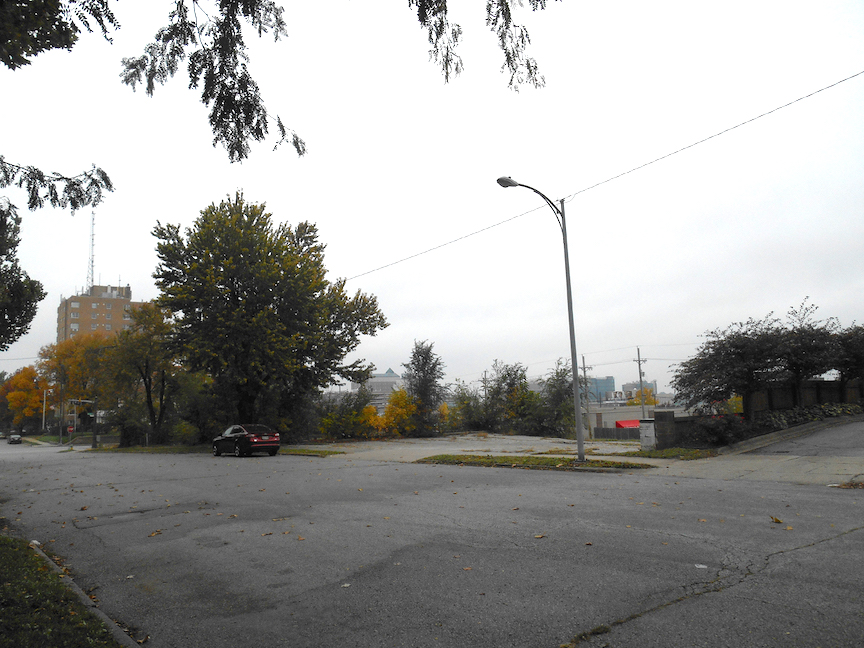
This is an image I captured of the former Travel Inn lot in 2016. The unoccupied property has remained in this state since 2006.

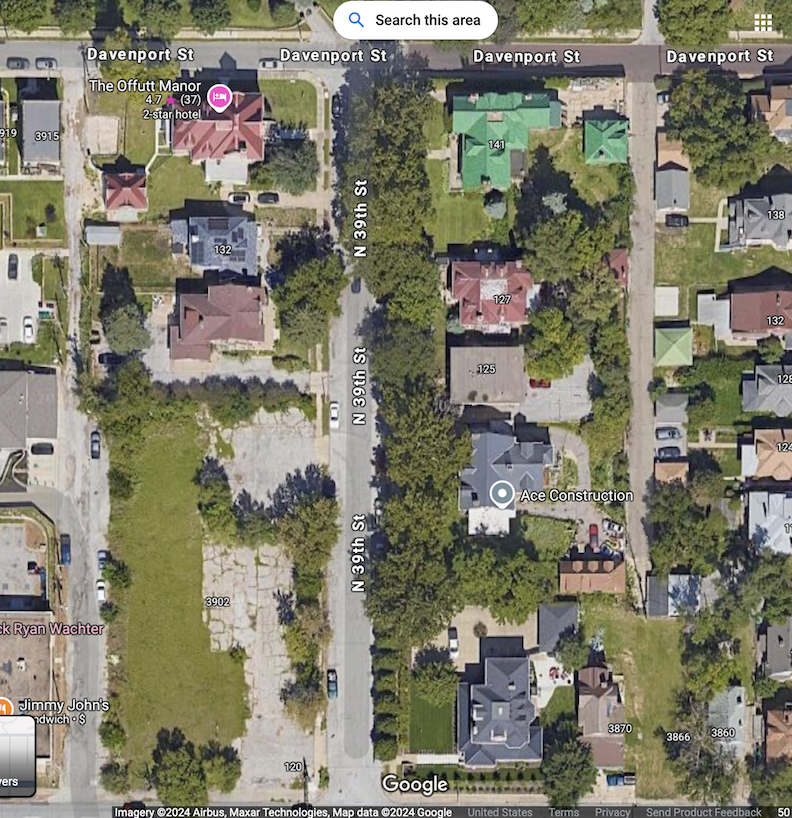
Apparently not the nice green space it looked like from the air. This vacant lot became a dumping zone.
Surprise! This last spring I saw a massive apartment complex being built on the site of the TraveLodge-Travel Inn. It was quite serious and I thought, well they’re finally doing it.
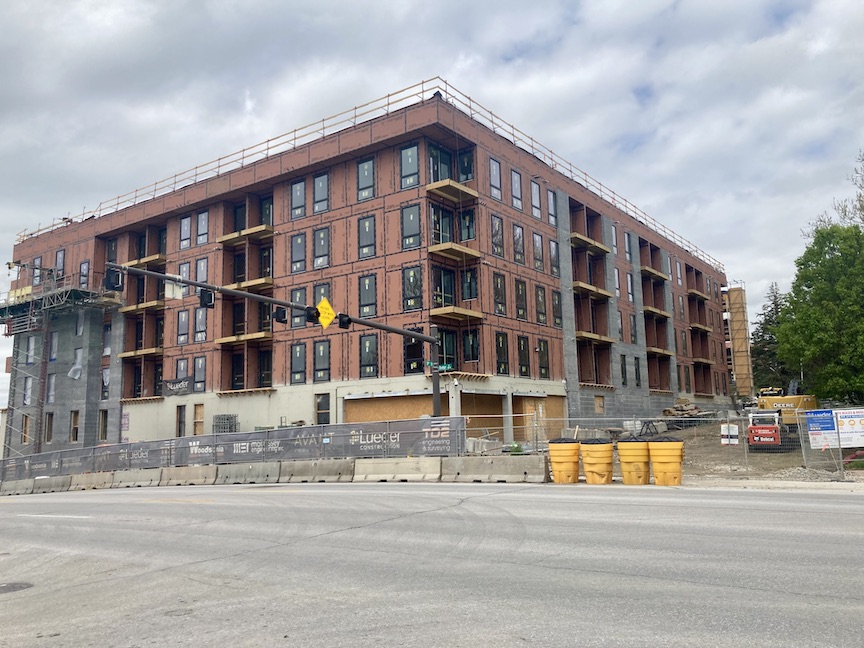
April 27, 2024. Camera facing north across Dodge.
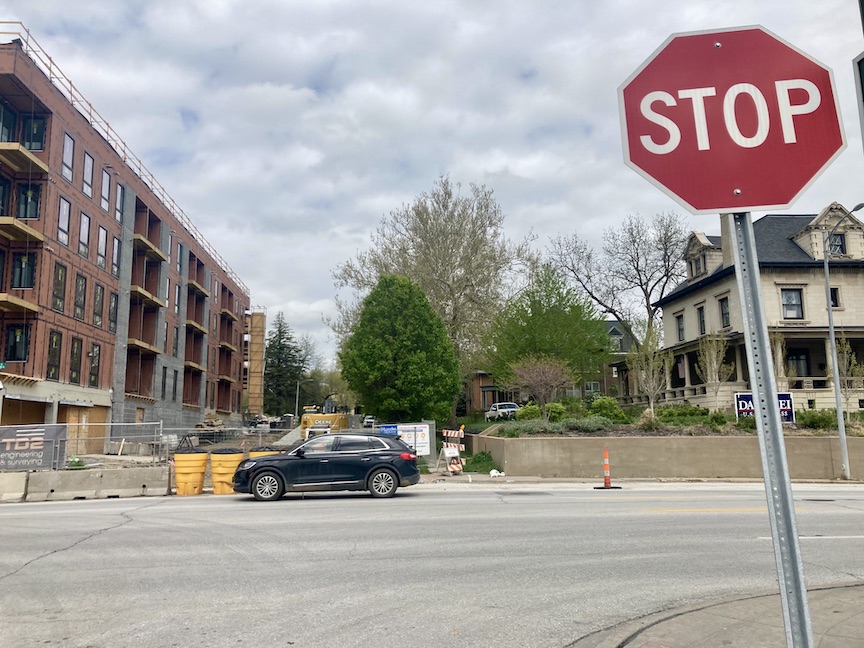
April 29, 2024. Straight shot looking north up 39th Street. The T. C. Havens House, at 101 North 39th Street is seen on the righthand side. No one is overwhelmed–surely not the building to the north at 130 North 39th Street. I must go take a peek.
I find it intriguing that access has been eliminated from both 39th Street and the alleyway off of Dodge Street. If you have not experienced it yet, one is no longer able to drive north on 39th Street from Dodge. The objective is to transform these sites into manicured green spaces.

Avant Architects computer design. https://avant-architects.com/projects/39th-dodge-apartments/
Woodsonia 3902 DODGE LLC is transforming this previously problematic location into residential flats. “With 30,000 square feet per floor, this 138-unit building is designed to cater to young business professionals in the surrounding neighborhood.” I have encountered it referred to as both The Artisan at 39th and The View on 39th. The approach is fundamentally identical to what is being offered locally and nationwide. “Relish in modern living at The Artisan at 39th. Our contemporary studio, one, and two-bedroom apartments are designed to offer the perfect blend of trend.” https://www.apartments.com/the-artisan-at-39th-omaha-ne/jvezyz4/

New configuration of the Woodsonia parcel–right across the once North 39th Street.
The Very End
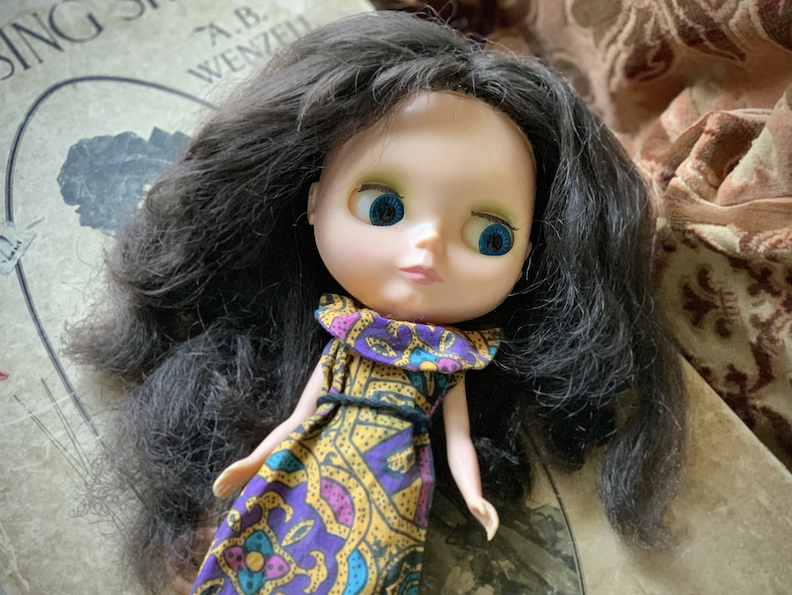
Inclusion of Blythe doll, to be read as a hard eyeroll.
Friends, I have whittled down my exiting words considerably in an effort at kindness. Let me be clear–I am happy that this vacant land is occupied. I am pleased that it is a residential property rather than a motel. I am satisfied with the number of windows present in this new large box. I would have preferred not to witness such an overwhelmingly large complex confined within that parcel. I sincerely hope this project can succeed inside this beautiful, historic neighborhood. North 39th Street and all surrounding blocks deserve the best after what is has endured. Omaha, what has our past taught us and does this new structure take into account those lessons?
With respect,
Miss Cassette


Once deemed much too aged to keep. Progress!
I welcome your feedback and comments on this fascinating Omaha landmark. Let’s hear it for North 39th Street, its history of owners and the gorgeous homes that remain. Please share your additional clues to the story in the “Comments,” as we know more together. Everyone would love to read what you have to say and it makes the sharing of Omaha history more fun. You can use an anonymous smokescreen name if need be. We want to hear from you.
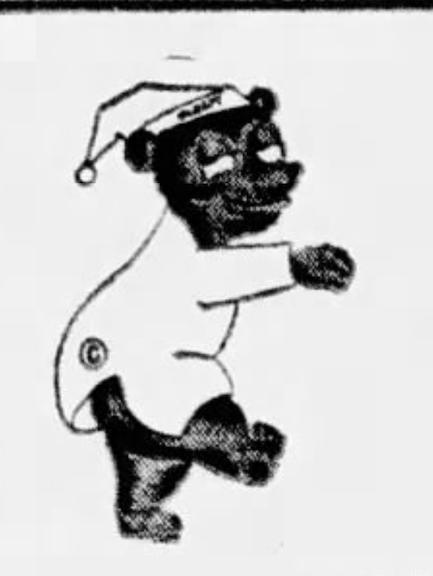
You can keep up with my latest investigations by joining my email group. Click on “Contact” then look for “Sign me up for the Newsletter!” Enter your email address. You will get sent email updates every time I have written a new article. Also feel free to join My Omaha Obsession on Facebook. Thank you, Omaha friends. Miss Cassette
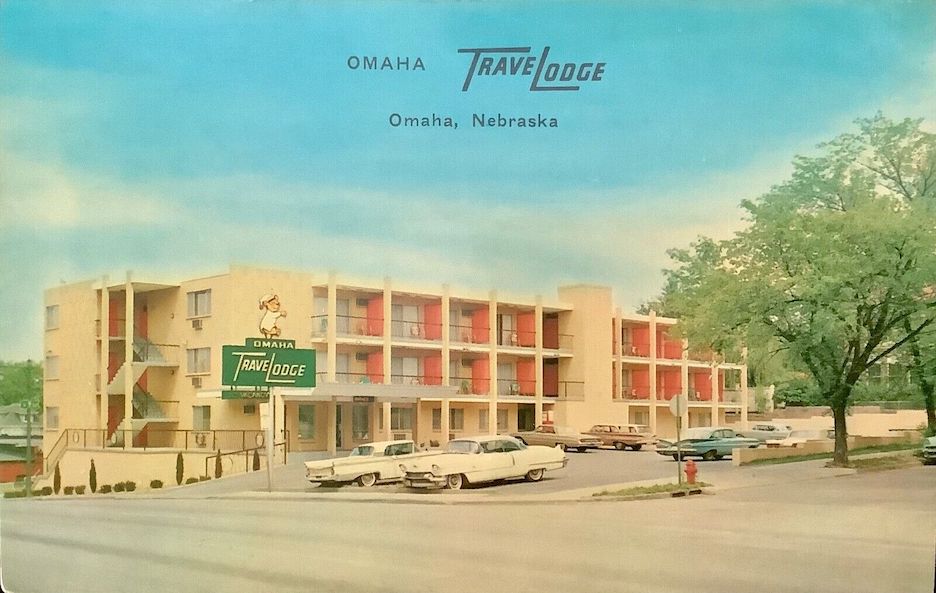
© Miss Cassette and myomahaobsession, 2024. Unauthorized use and/or duplication of this material without express and written permission from this site’s author and/or owner is strictly prohibited. Excerpts and links may be used, provided that full and clear credit is given to Miss Cassette and myomahaobsession with appropriate and specific direction to the original content.

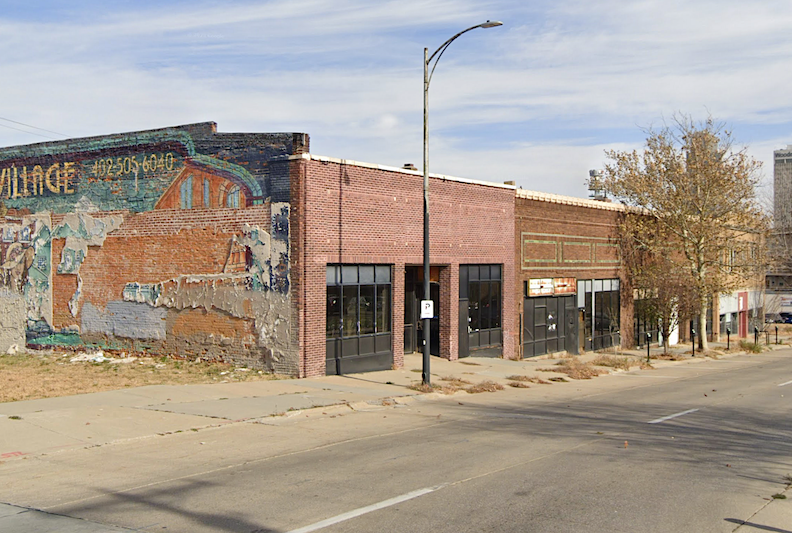
As a kid growing up, I was looking for something in one of the drawers of my Great Grandmother’s buffet and found a small cache of Omaha Travel Lodge swag items with the Sleepy Berar Logos which included about 4 post cards, about 10 match books, 2 ash trays, and two pens. This would have been around 1967 to 1969. We had extended family who resided in California who would travel “back home” to Omaha, each summer. According to Grandma, these were given to her by mu Aunt and Cousins when they stayed at the Omaha Travel Lodge when it was still fairly new, around 1962 or 1963.
During my time as a Law Enforcement officer during the 80s and 90s, we were well aware of the Travel Inn and what was going on there. While I was a cop in the western suburbs of Omaha, it was not uncommon to have investigations which stretched into Omaha proper, and had one case where we had to go after a fugitive who was reported to be at the Travel Inn. …And as the Omaha Police Officer whom you quoted, calling it a Sleaze Dive barley described it. We were advised NOT to go in their without back up..
Keep up the writing of these great stories!!
Thank you for this insight, Randy. Interesting to find this stash that you did. I loved the Sleepy Bear sign so much when I was little. But we never stayed at one that I remember, although I do remember Howard Johnsons well from family trips. That big orange Mid-Century roof was so cool and I always wanted to lodge where there was a pool. I was grateful to Officer Langan for writing all he did and capturing the behind the scenes that would be impossible for me to find in newspapers. I have referred to him over the years and always appreciate his interpretation. I might need to reach out to you in the future, if you don’t mind. Thanks for sharing!
It’s infuriating what the mid-century did to our historic architecture, and perhaps even more so now they are replaced with cheap construction. It looks shiny and new today, but one can’t help but wonder how these stick-built structures will age. Thank you for another fascinating read.
When you rip a hole in the urban fabric and destroy integrity, there’s no going back. History will repeat itself. Artless boxes are the future slums.
Thank you so much for writing in, Sarah. It’s a new shiny thing and everyone is excited. We’ve seen this before.
So interesting! Thank you for this article. I, too, am partial to the cute little bear of TraveLodge because my grandparents managed one in Grand Island sometime in the 60s. I was so excited to go stay in a motel (and it had a pool!).
It makes me cry that they destroyed completely wonderful old homes!!!
Great write up as always. one comment about “Nob Hill.” I like the idea of it being related to Hob Nobbing, but I believe they were just copying the rich neighborhood from San Francisco known as Nob Hill. In the late 1800s when San Francisco was developing, 4 wealthy railroad magnates built homes on a SF Hill. A term was coined for these rich men from the east, “nabobs.” It was shorted to Nob and their mansions and eventually the surrounding area became Nob Hill. I guess with Omaha being a railroad town that term must have made it’s way here too once the wealthy started building mansions around that area.
Thank you! Great connection. You are surely correct. Much appreciated.
Back in the early/mid 70’s there was an enormously obese woman that work the overnight shift at the Toddle House. She occupied most of the space behind the lunch counter. There seemed to be a small crowd of East Omaha types that were there when she was. If they were into the meth available back then, they sure weren’t sharing.
The new box is ugly, arrogantly obese, and reminds me of that woman. No reason for it to be that big and ugly.